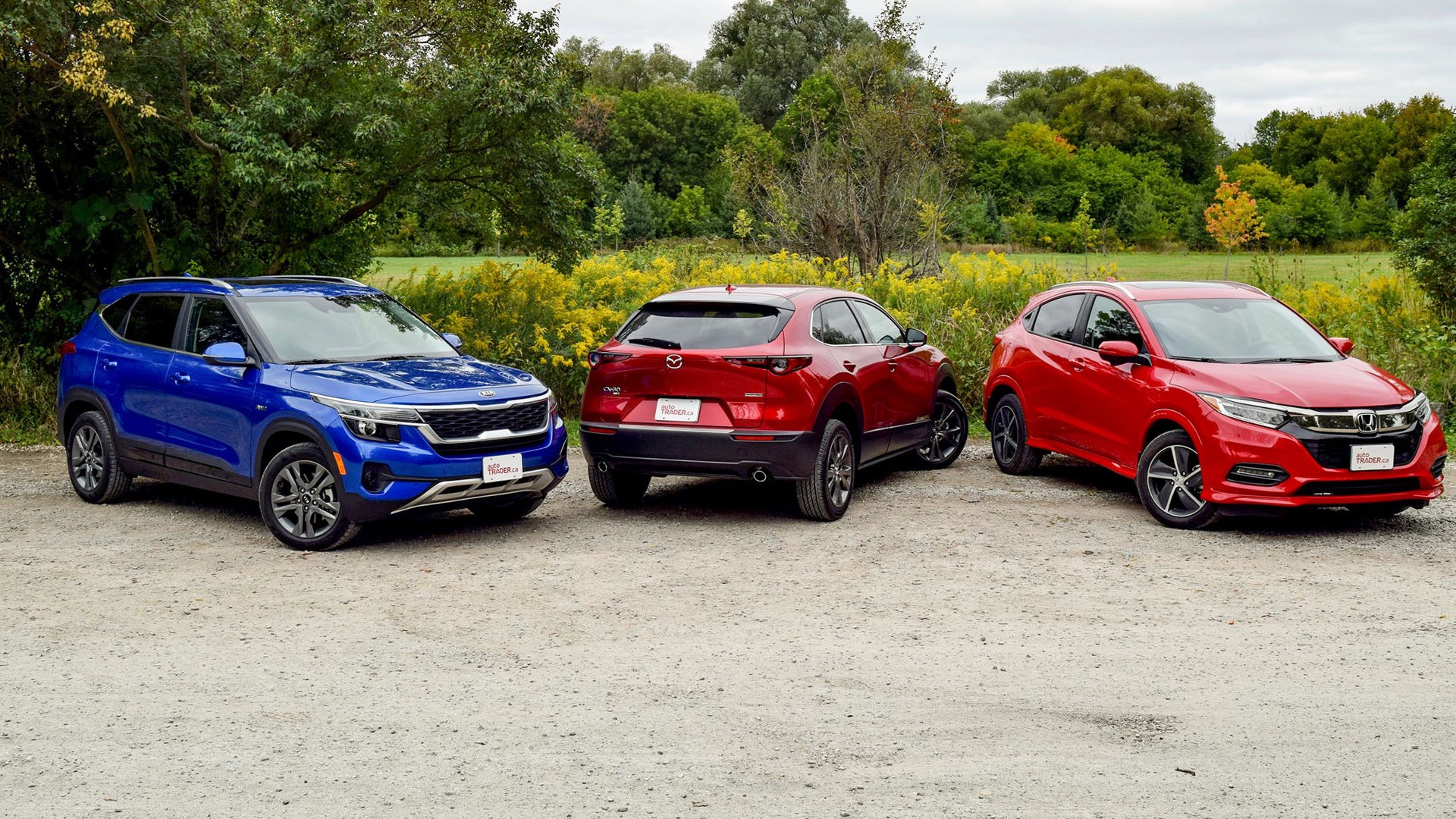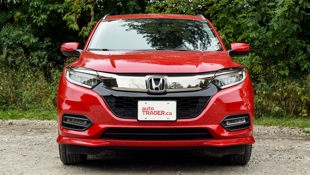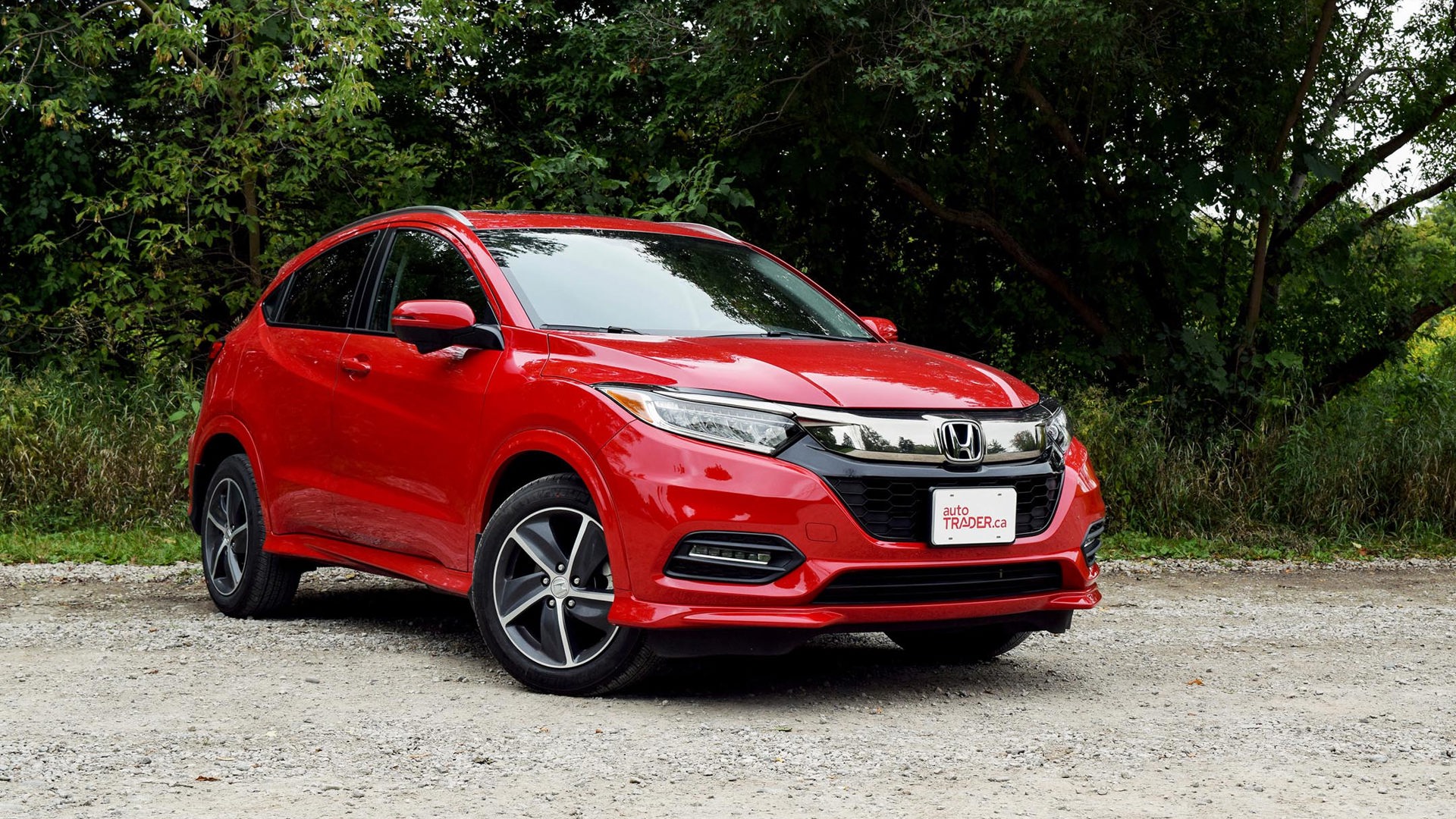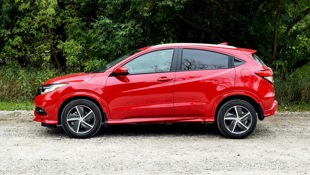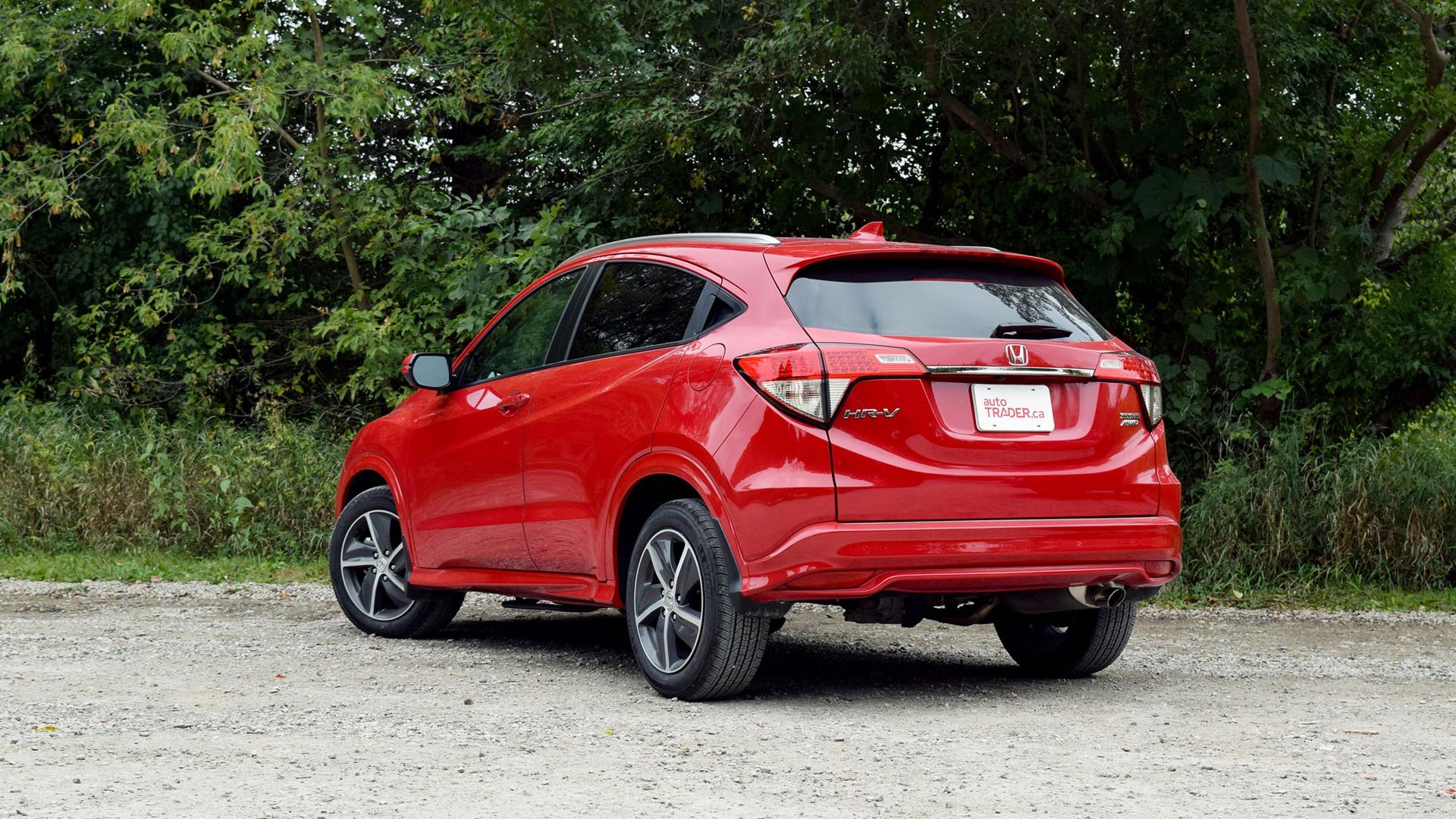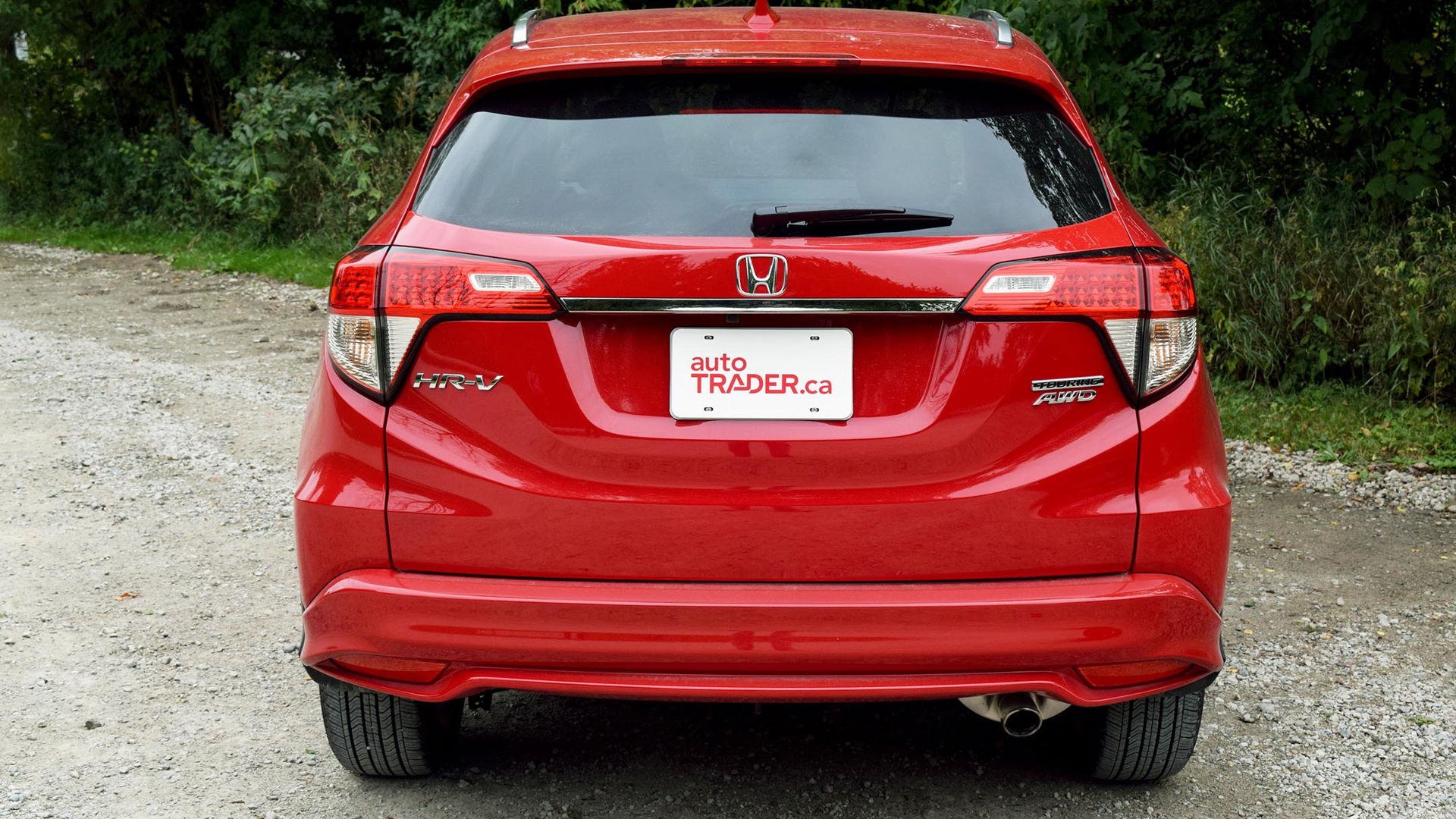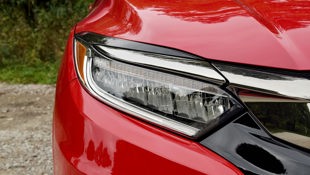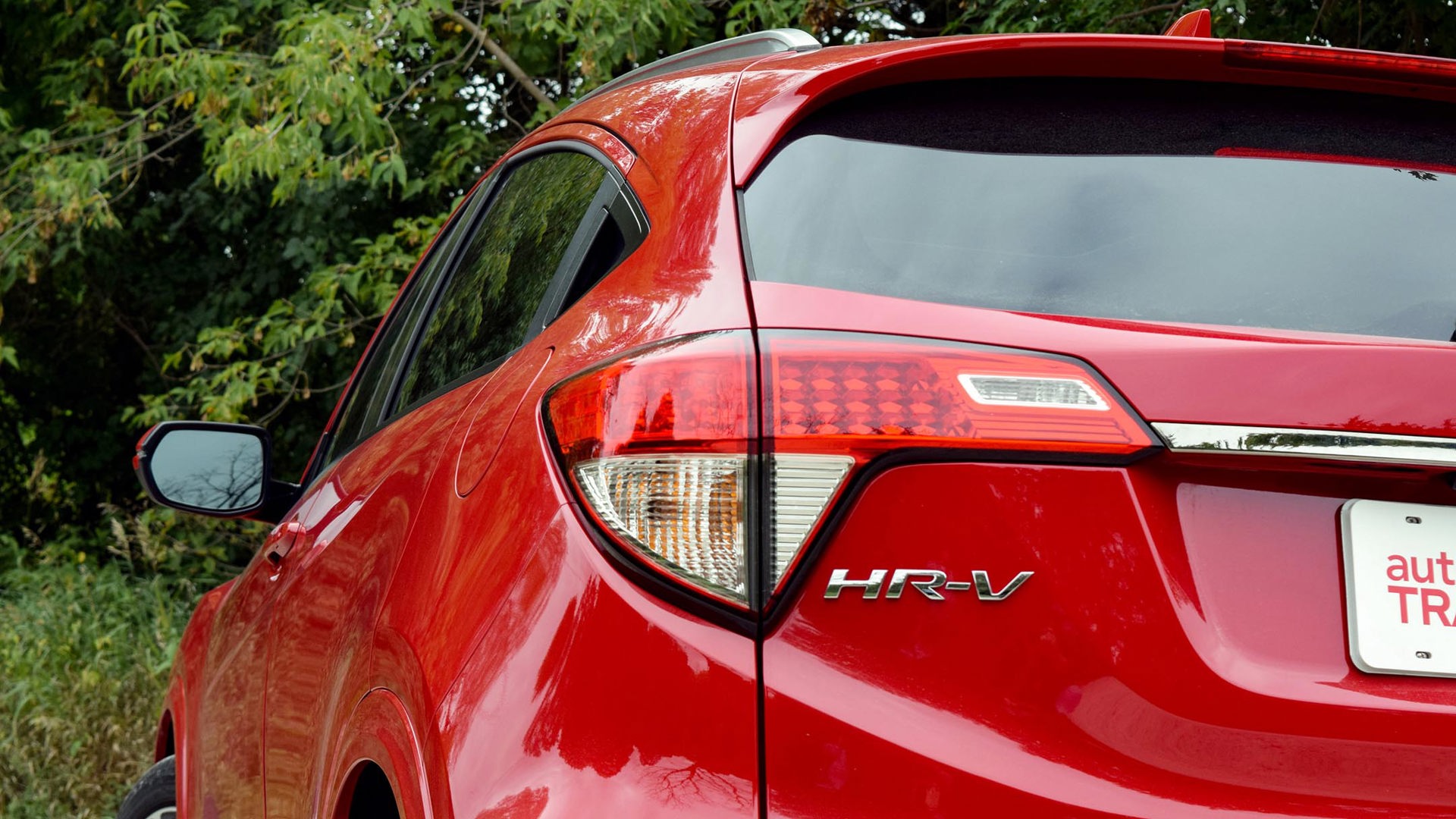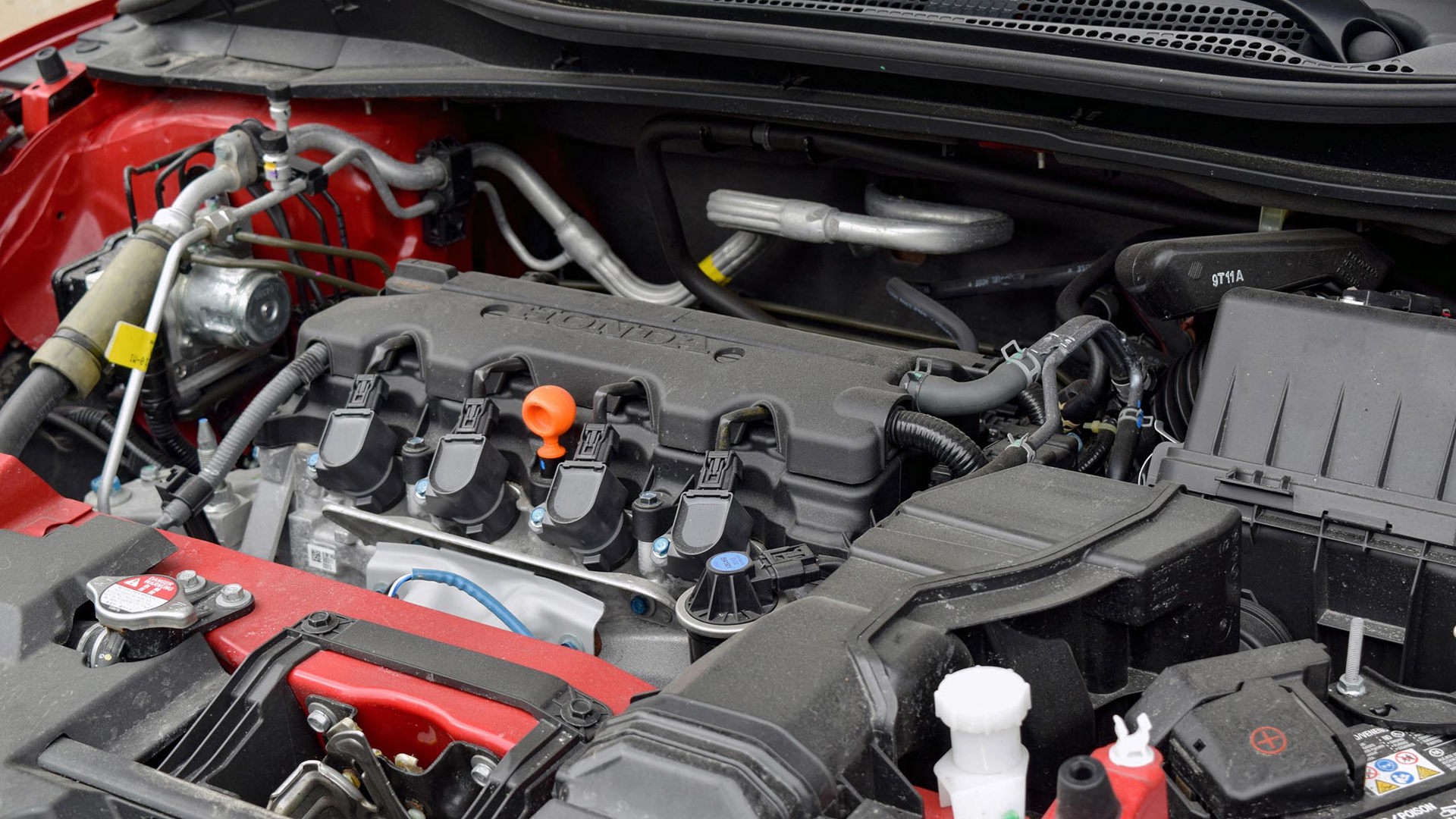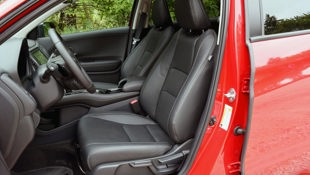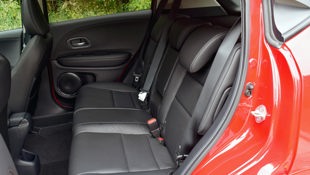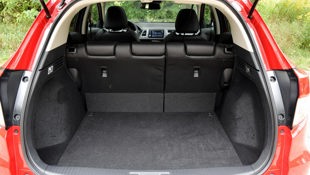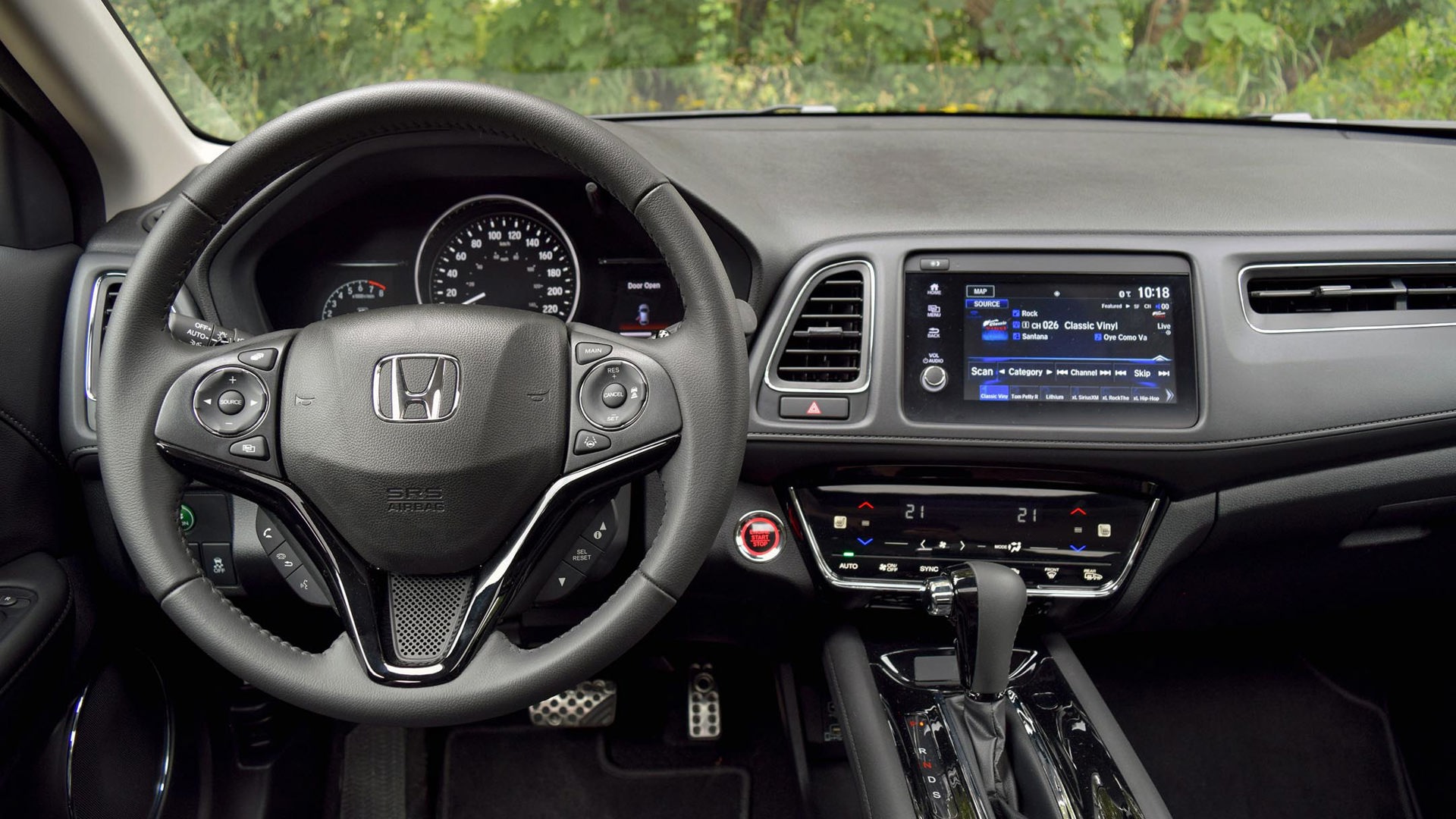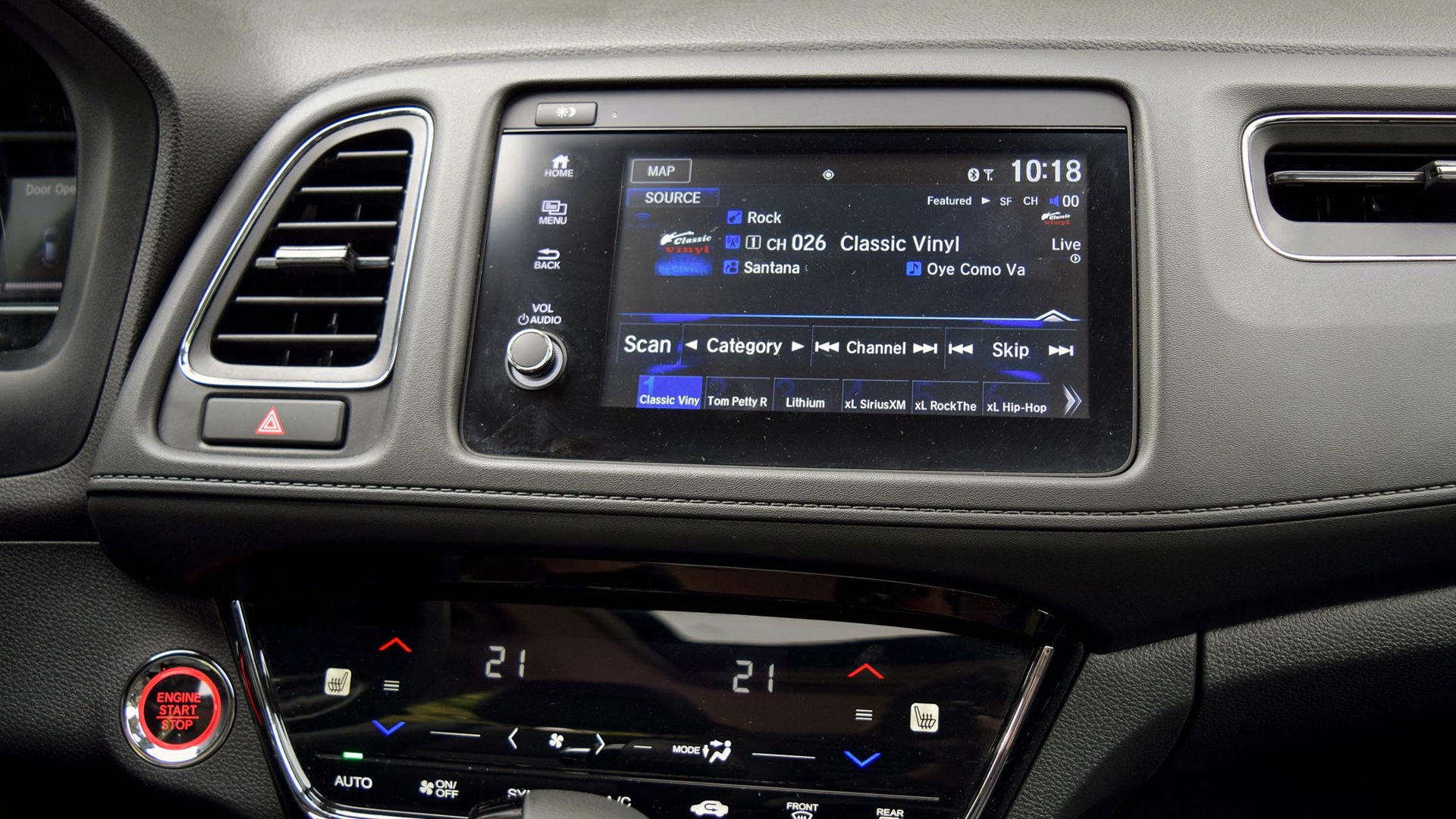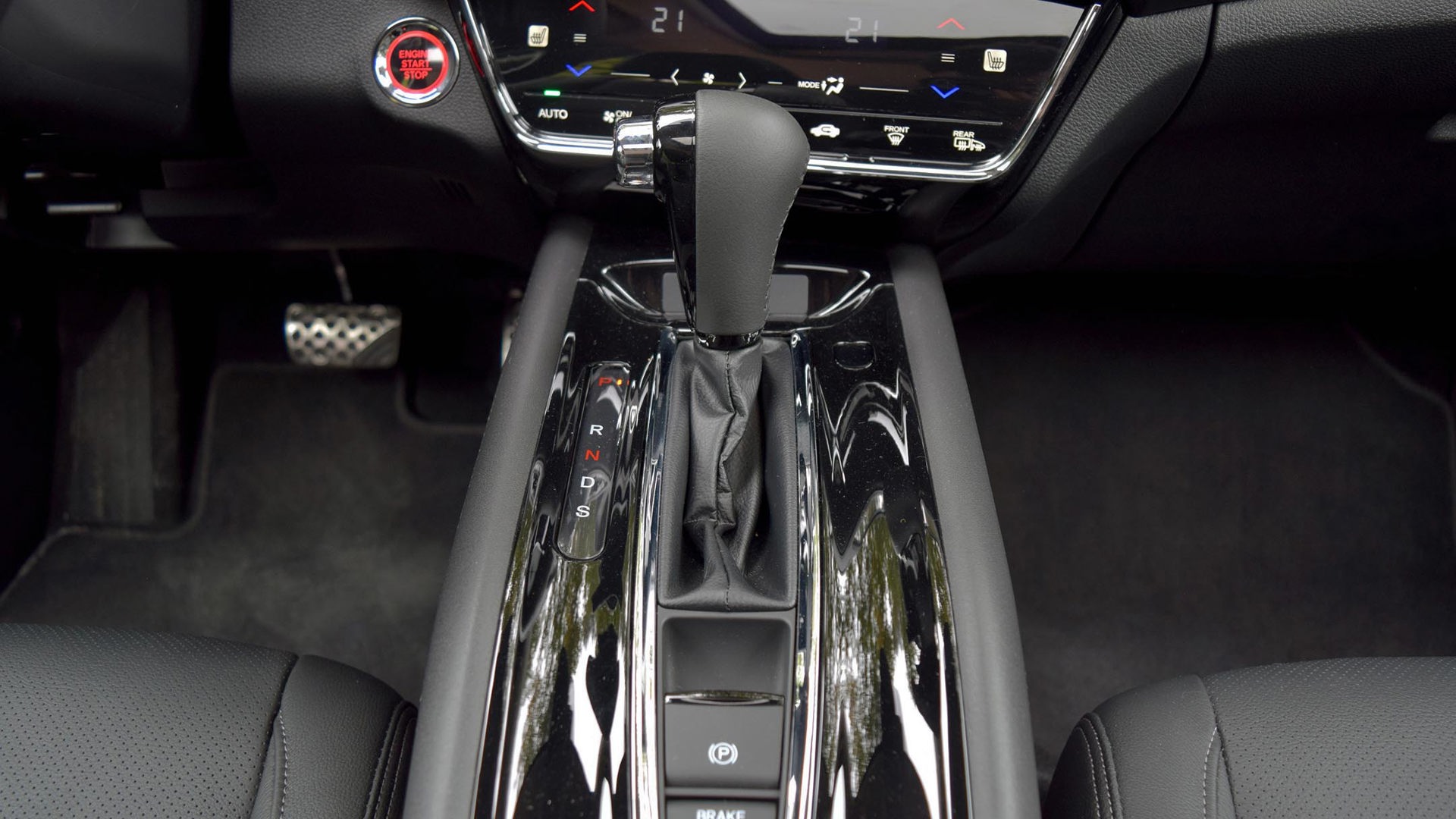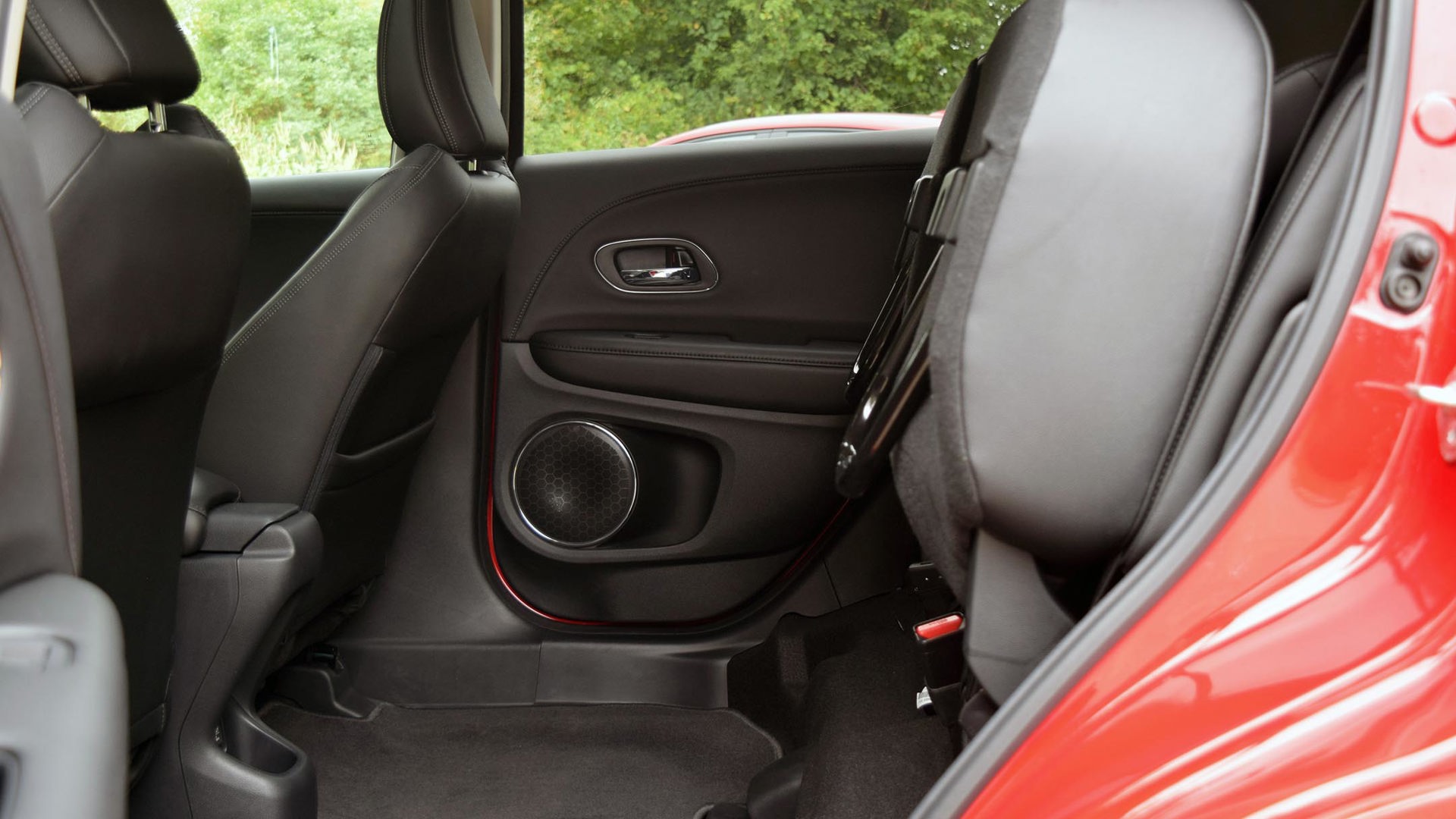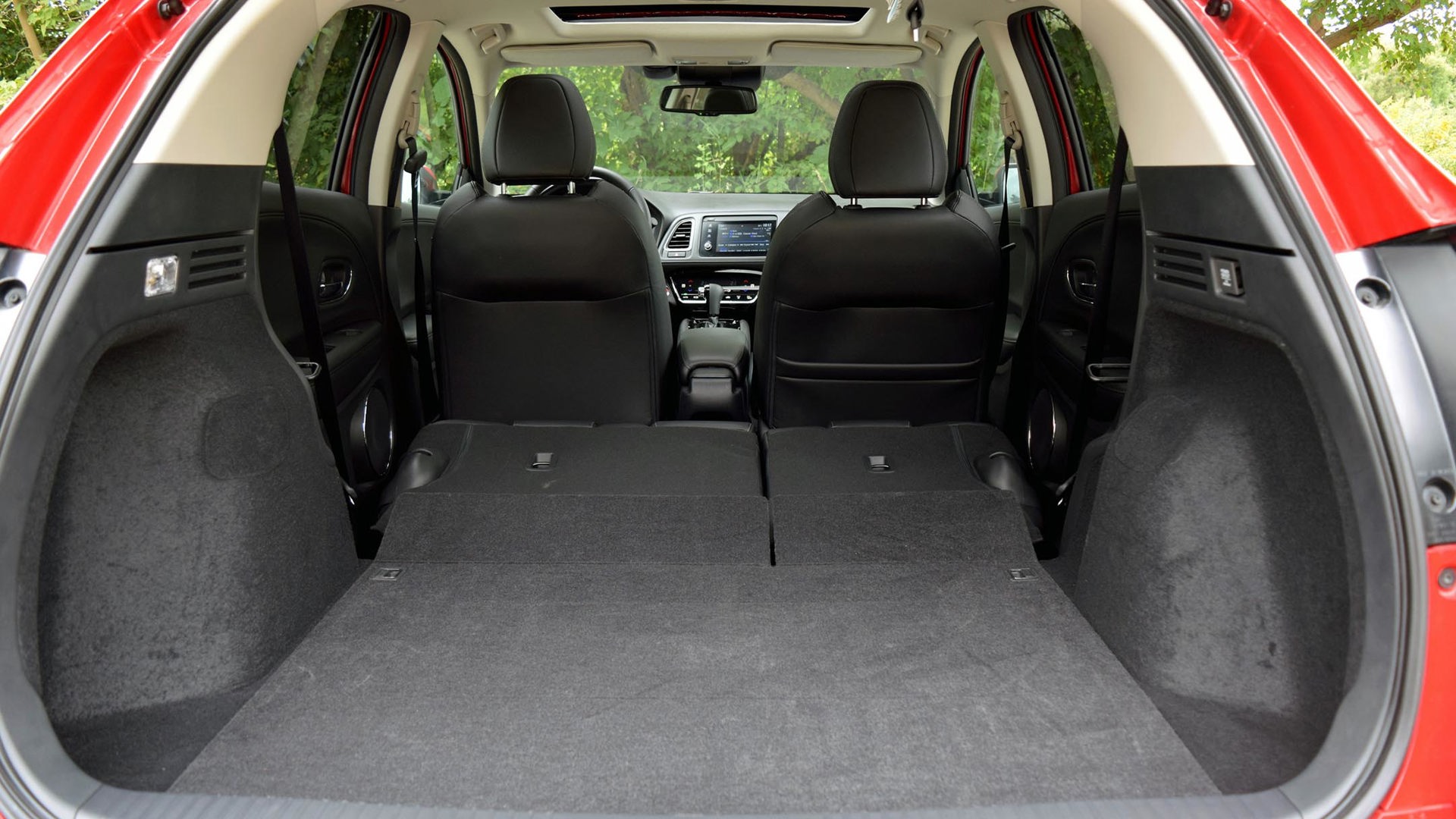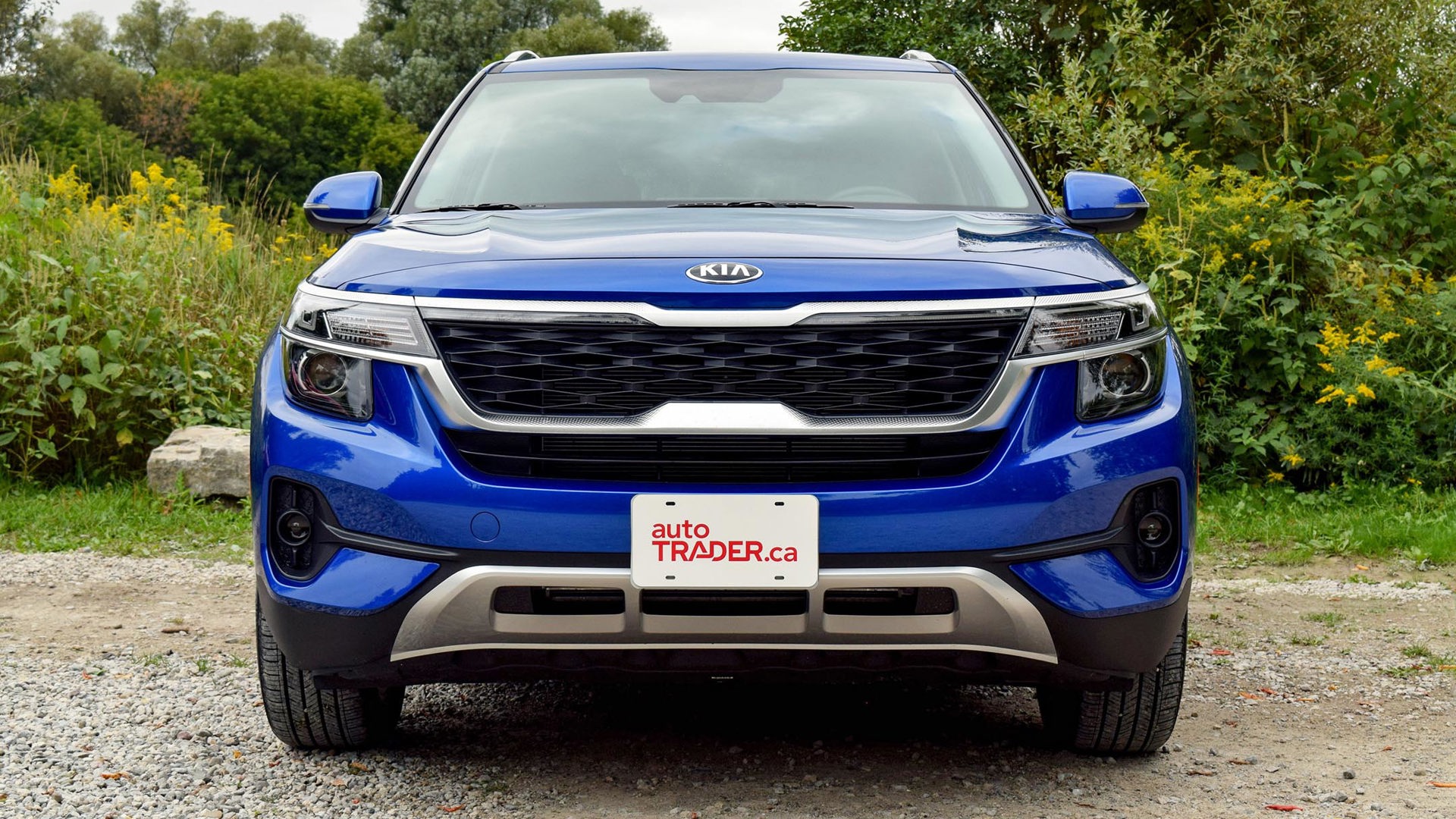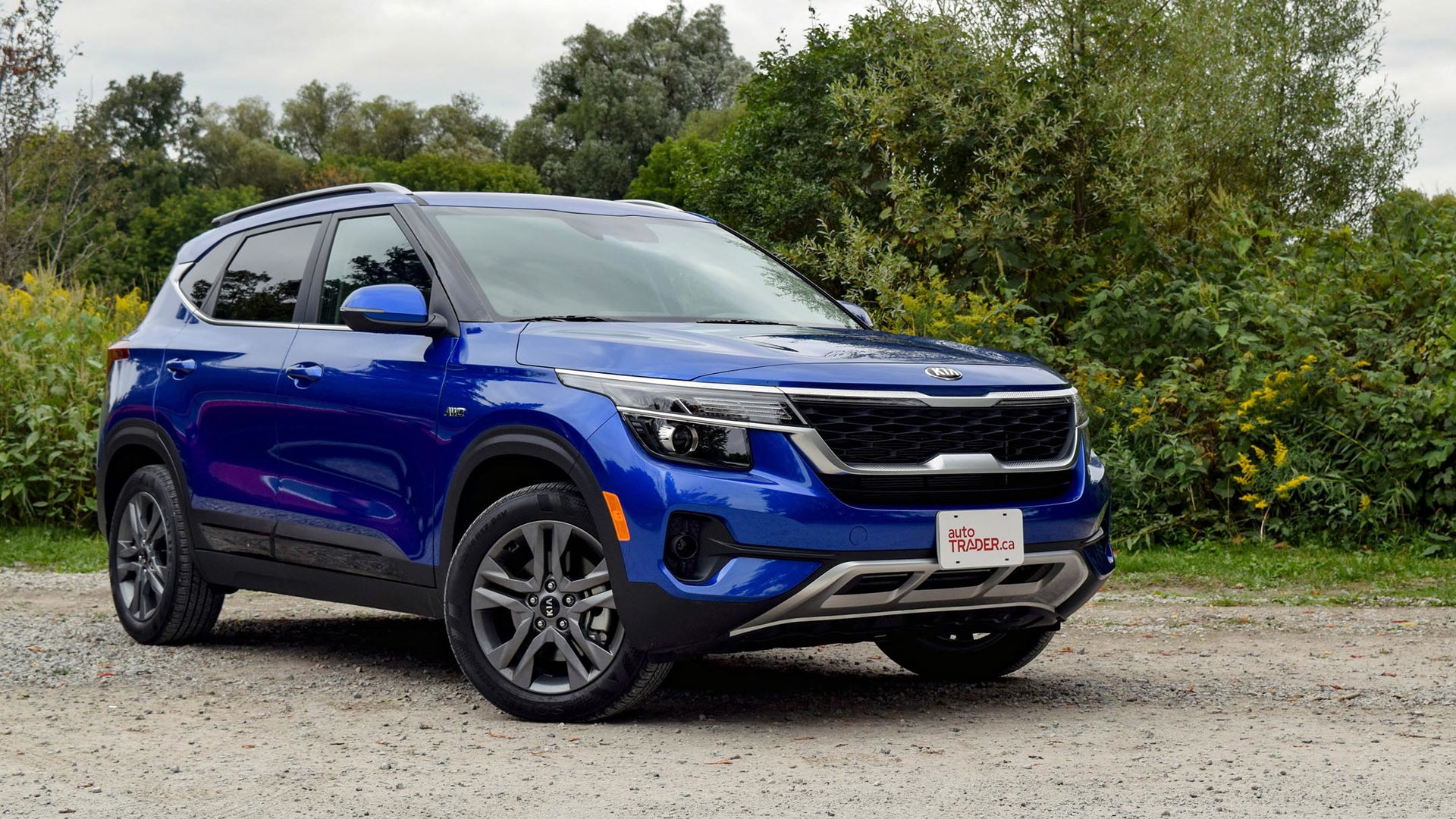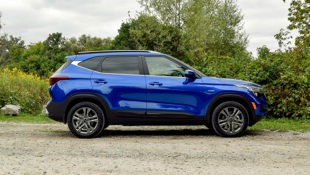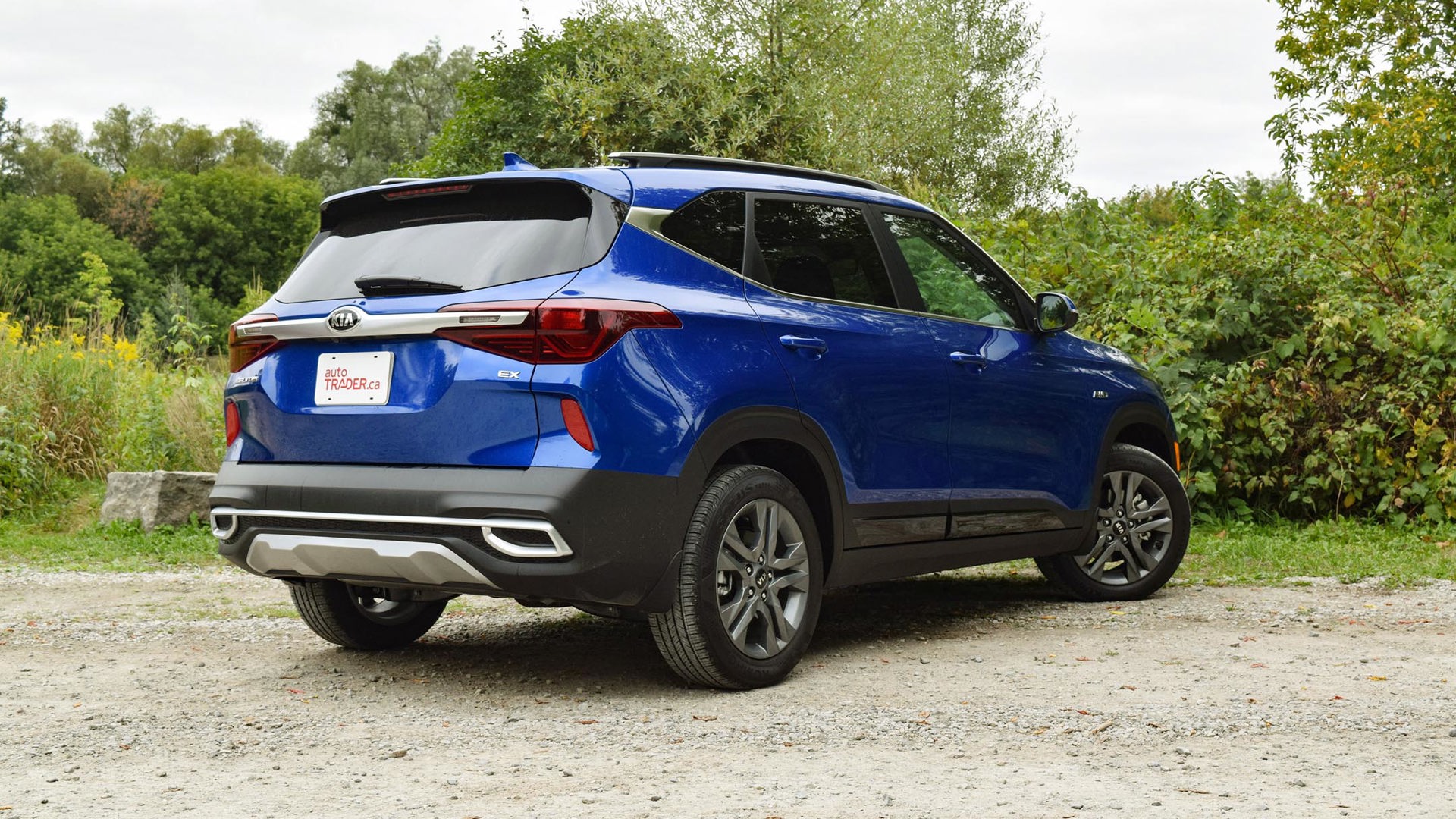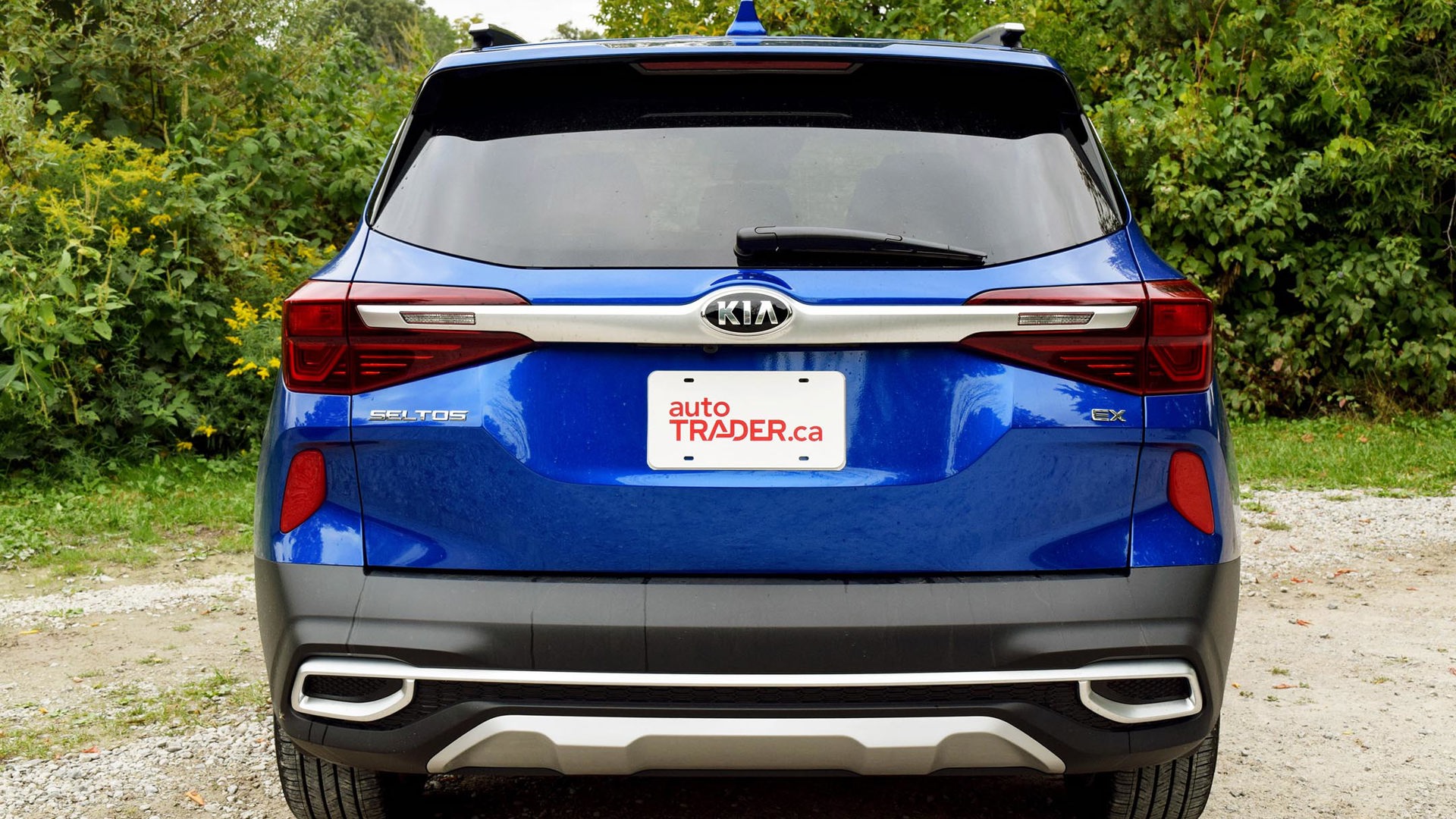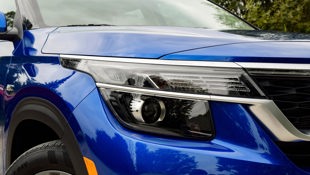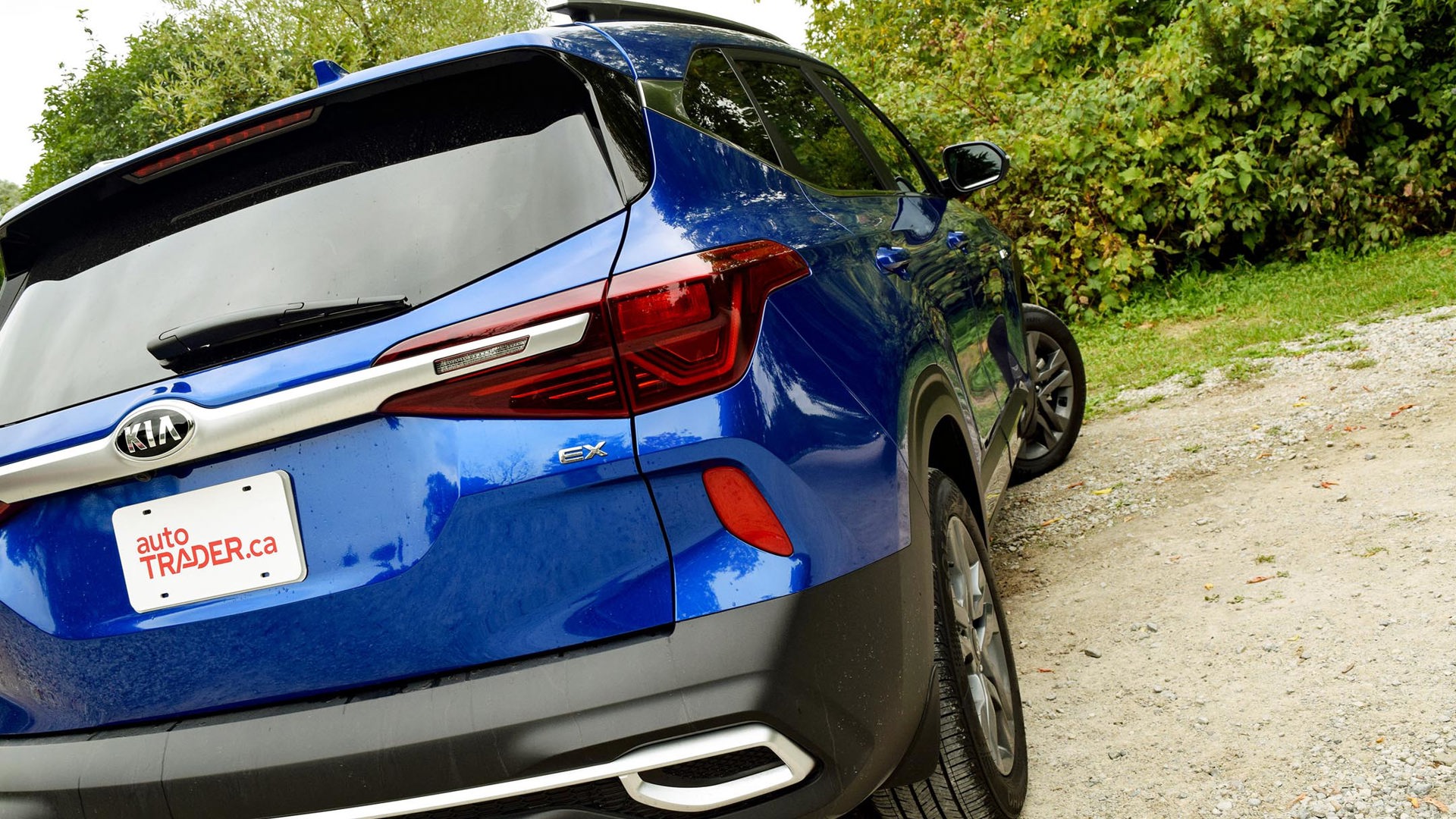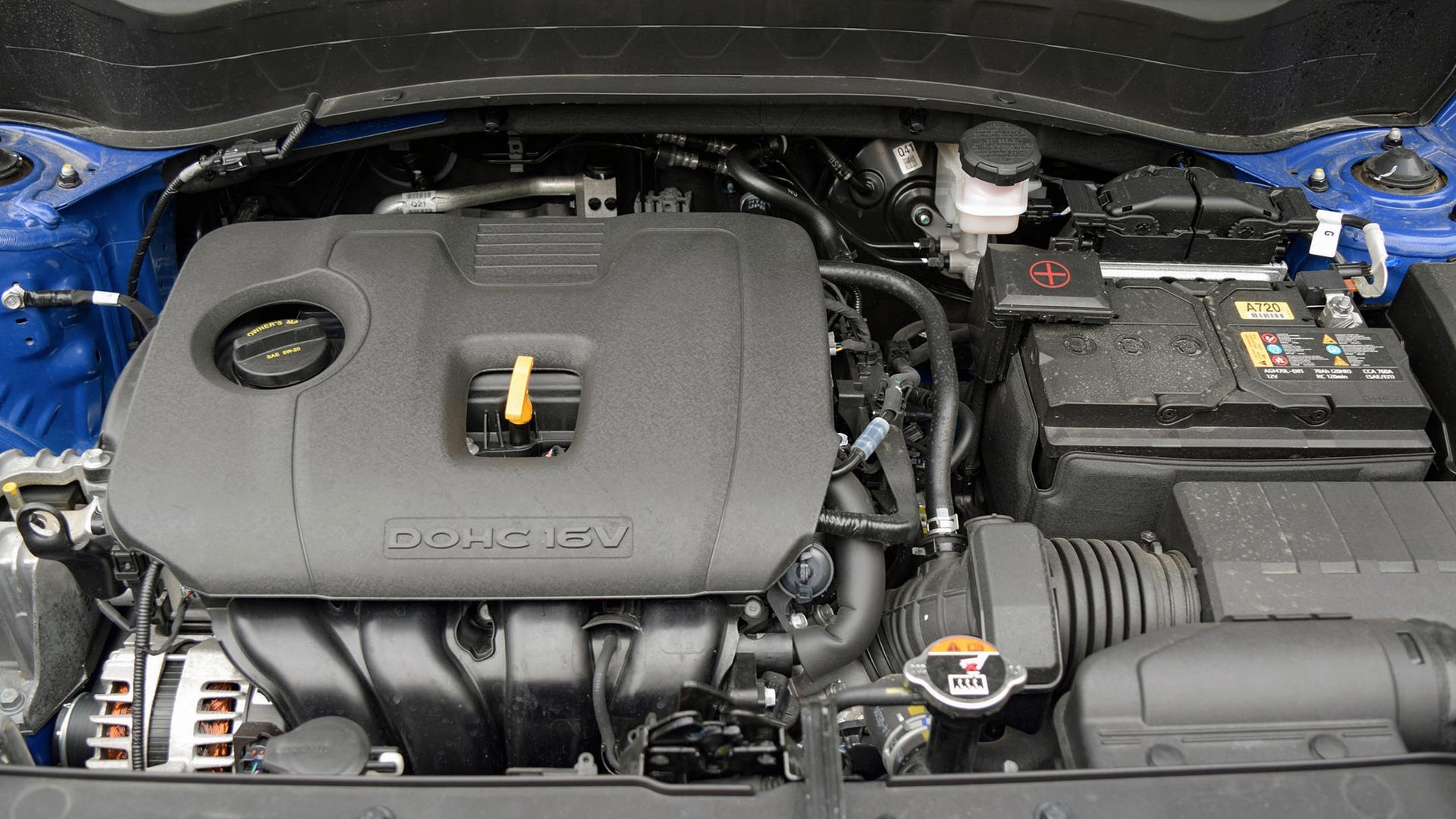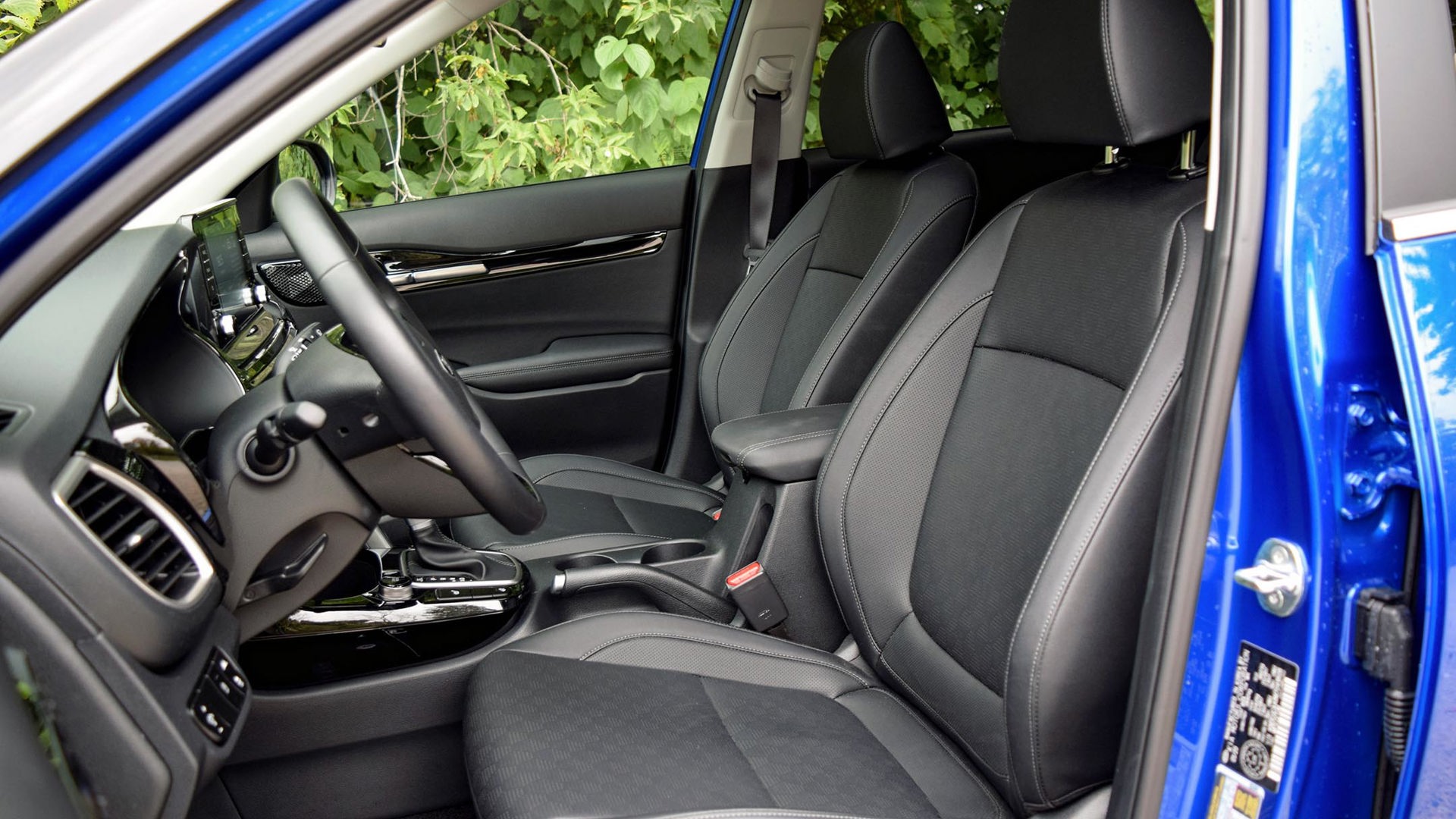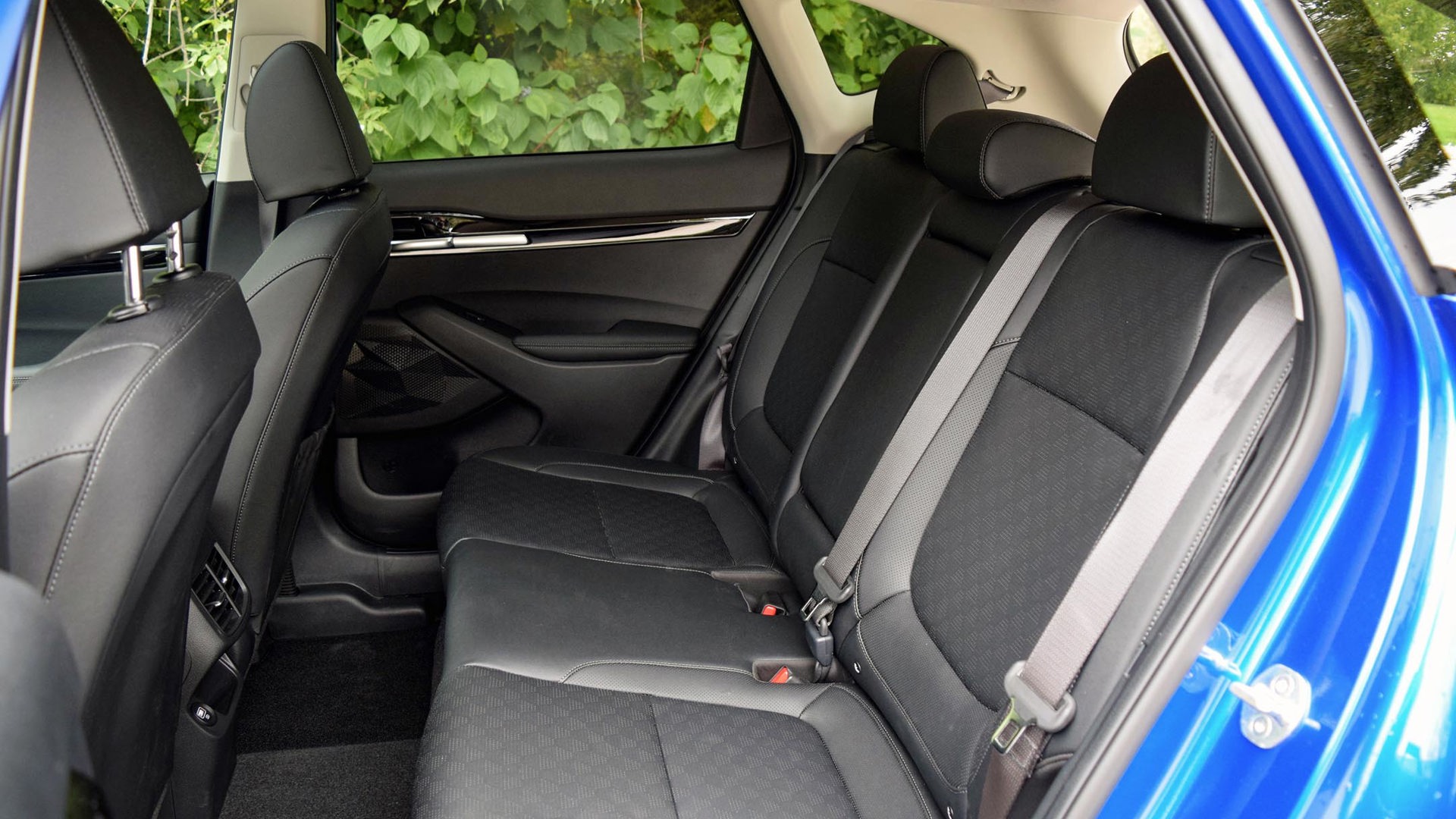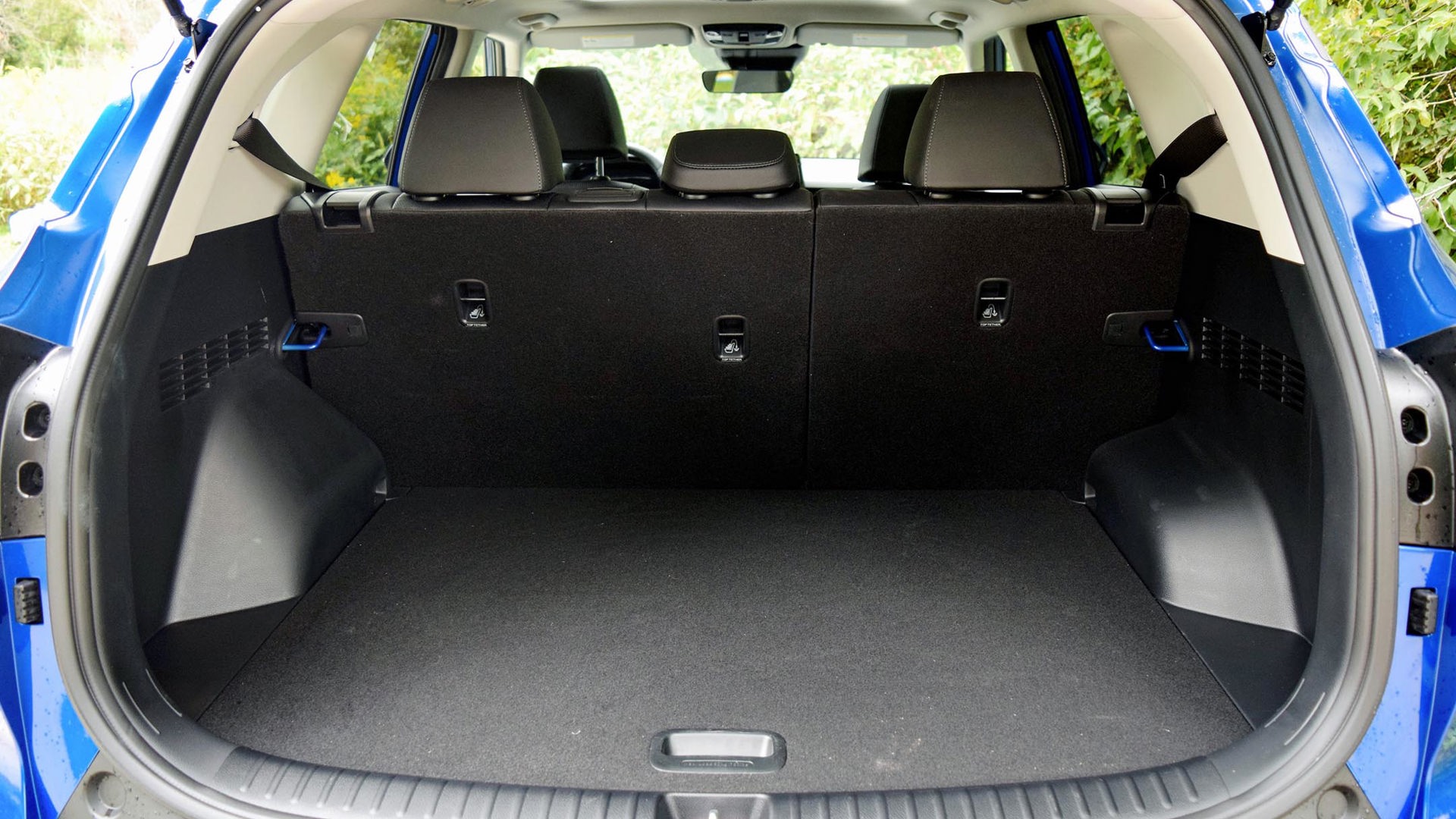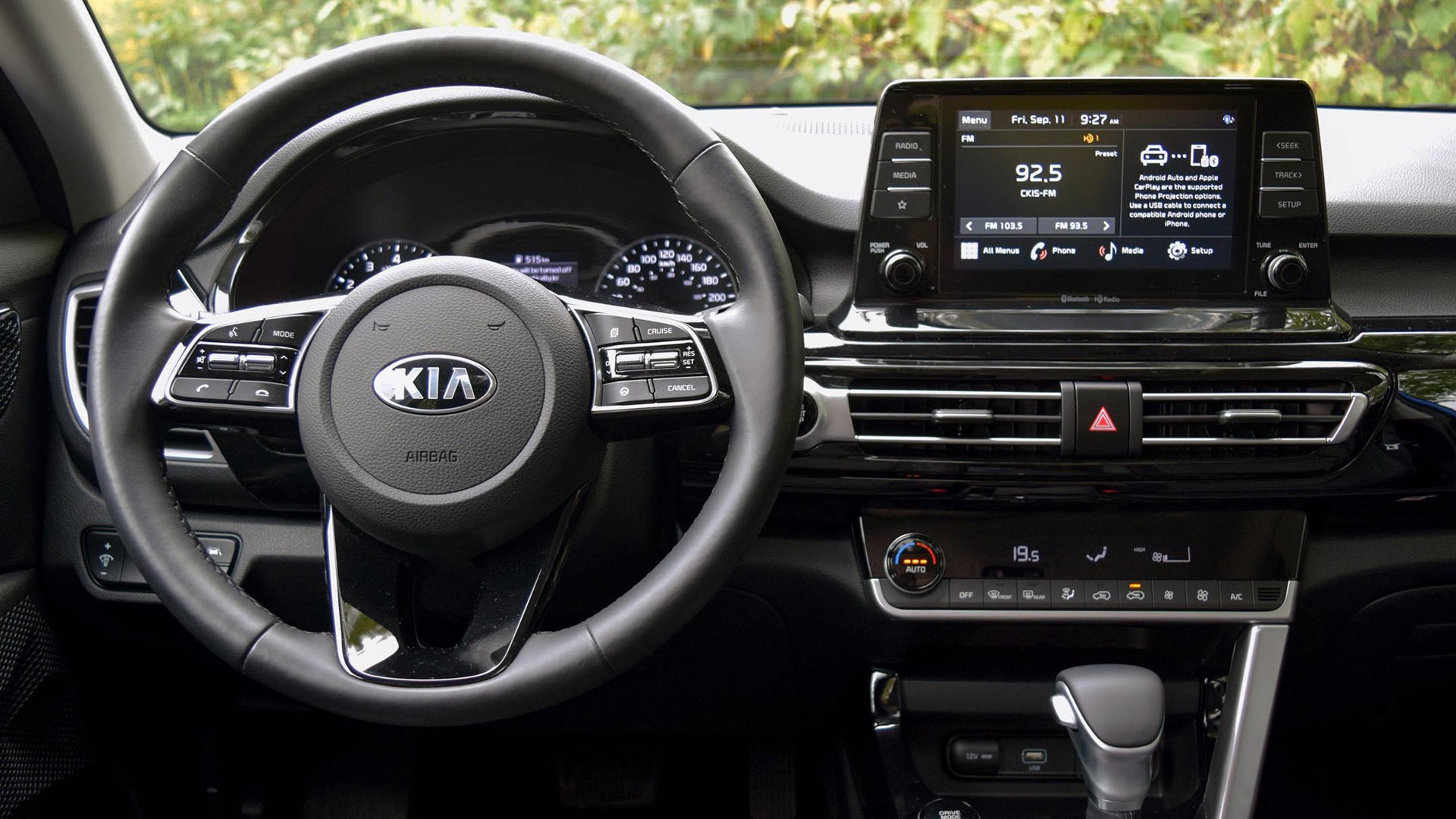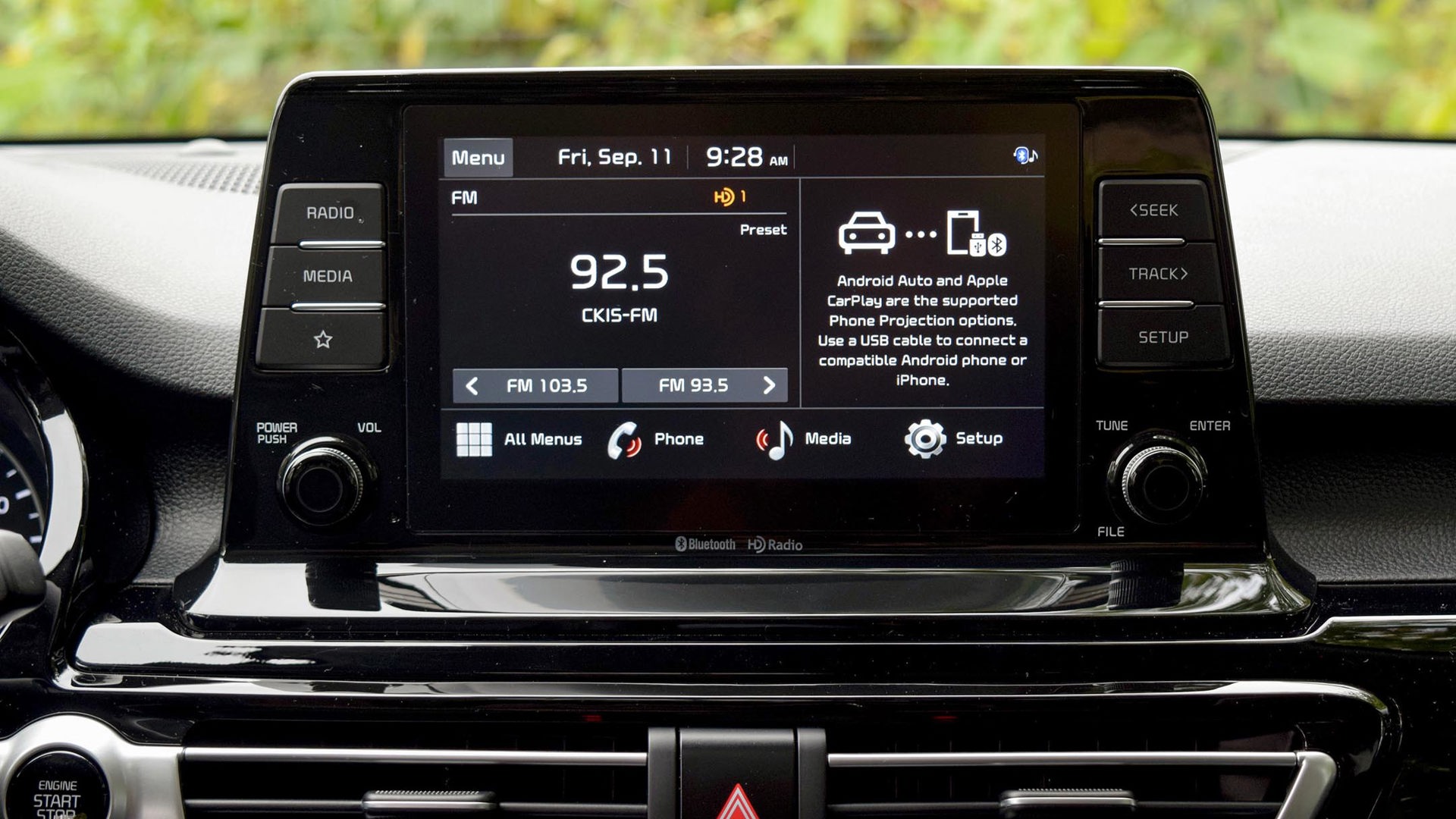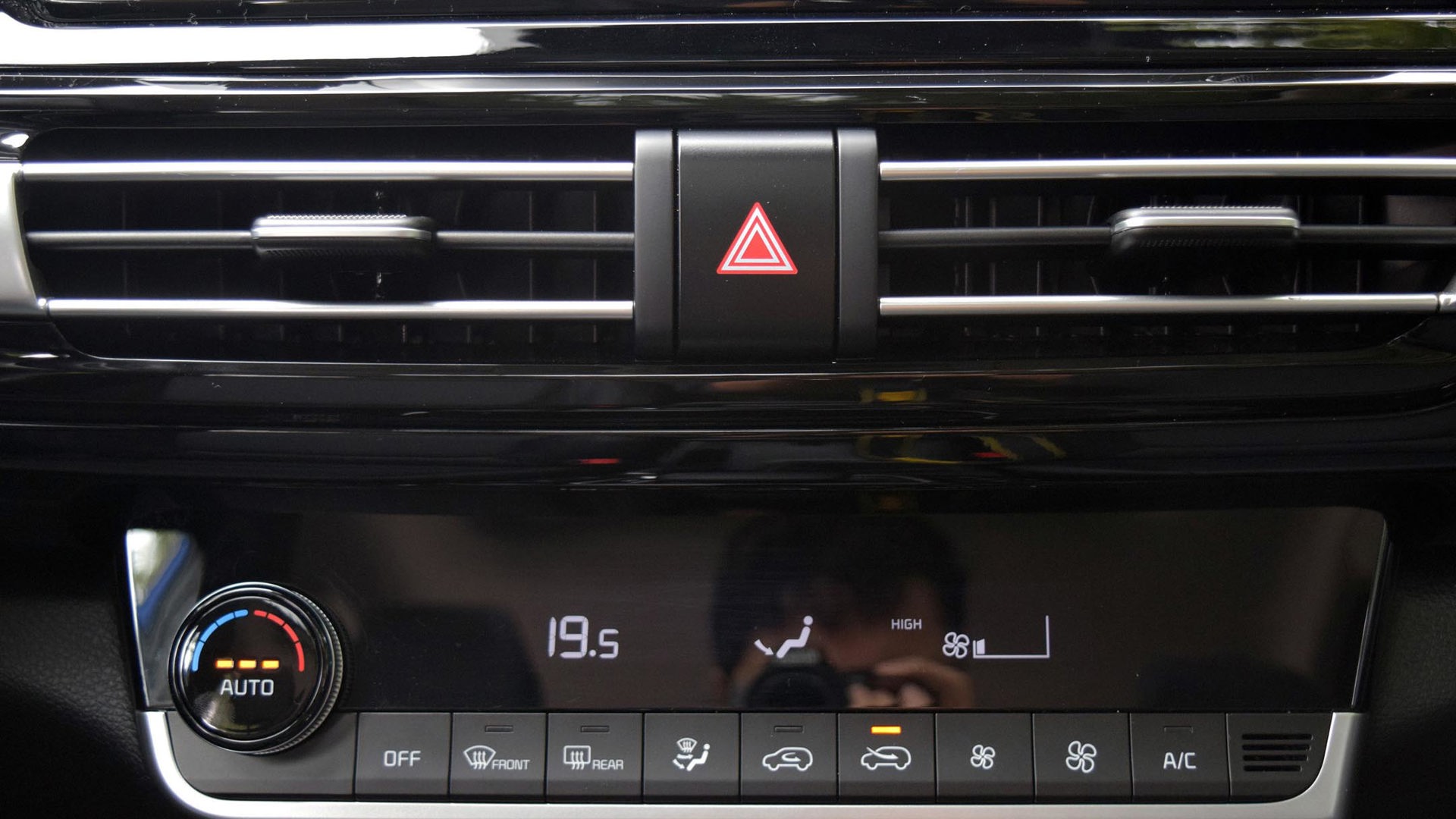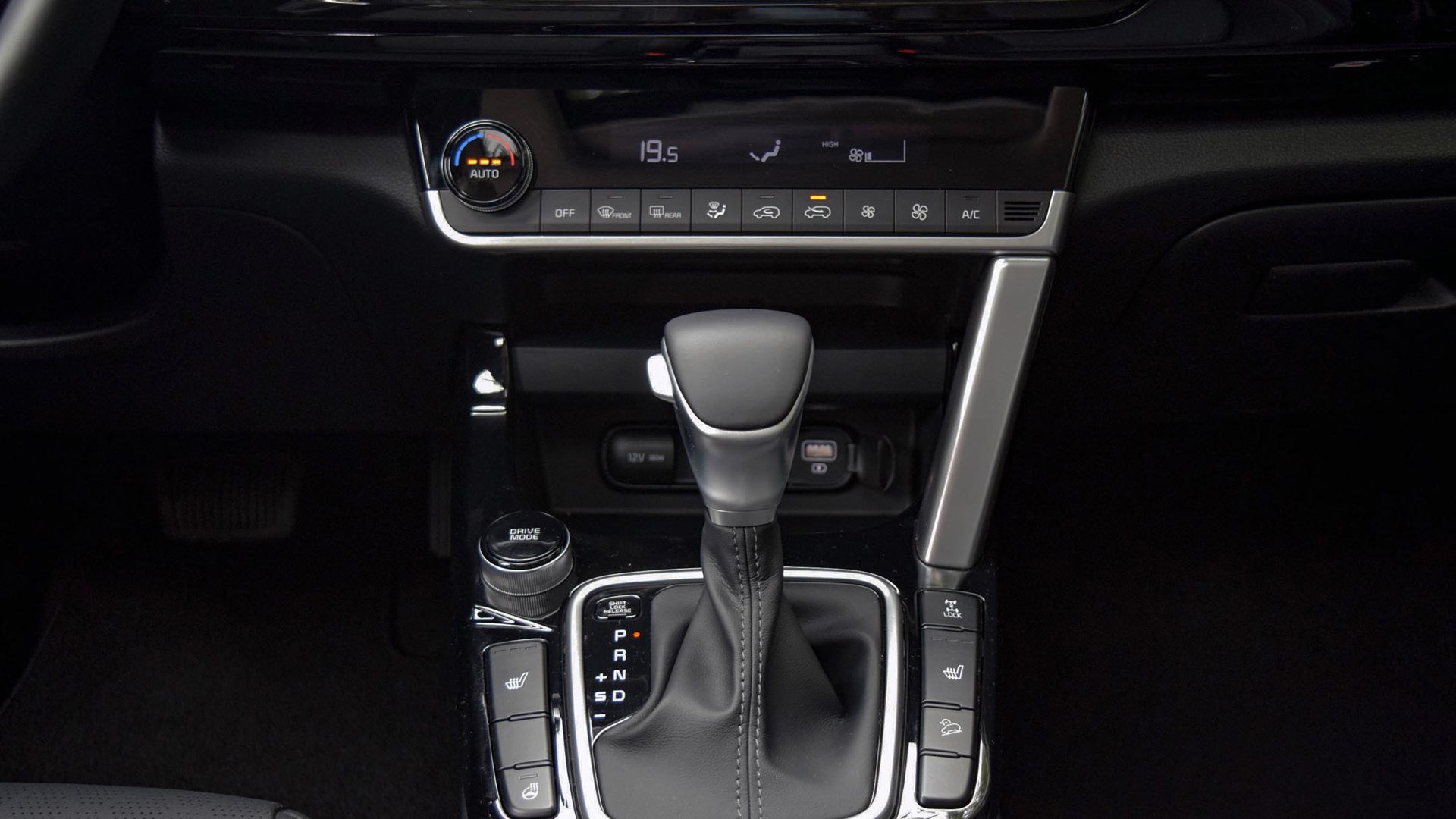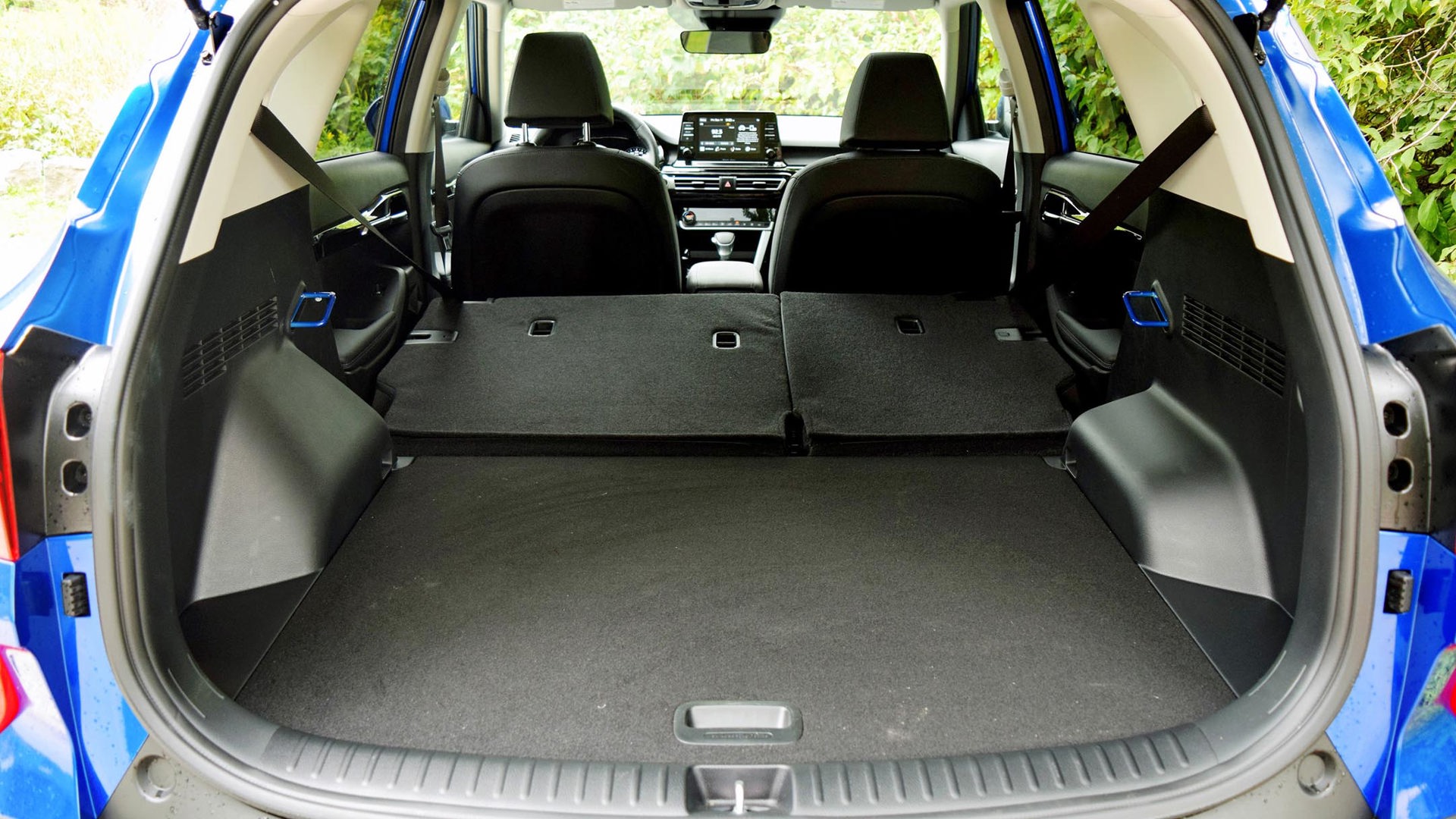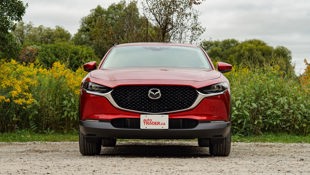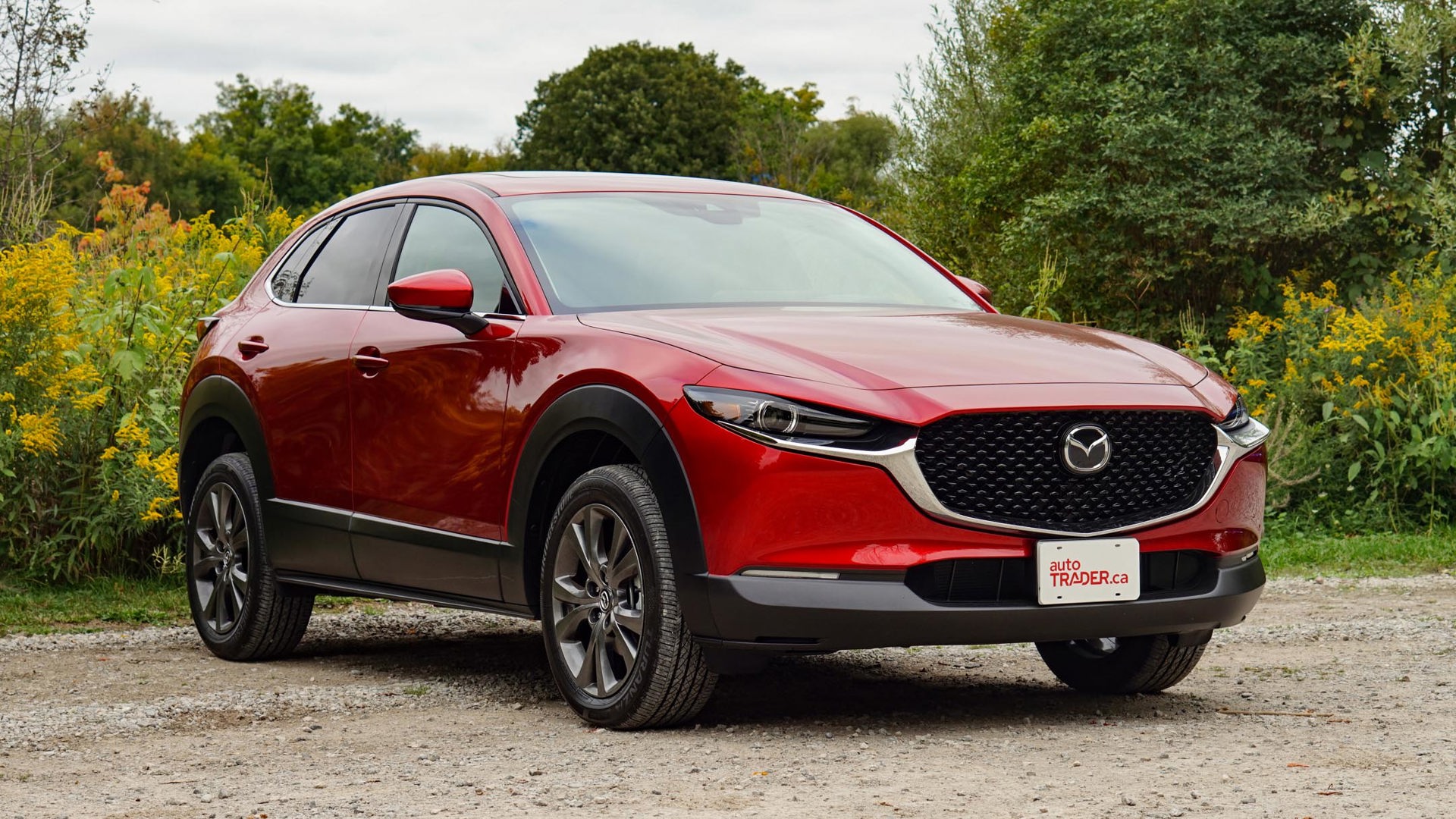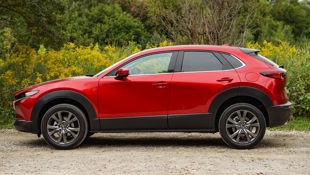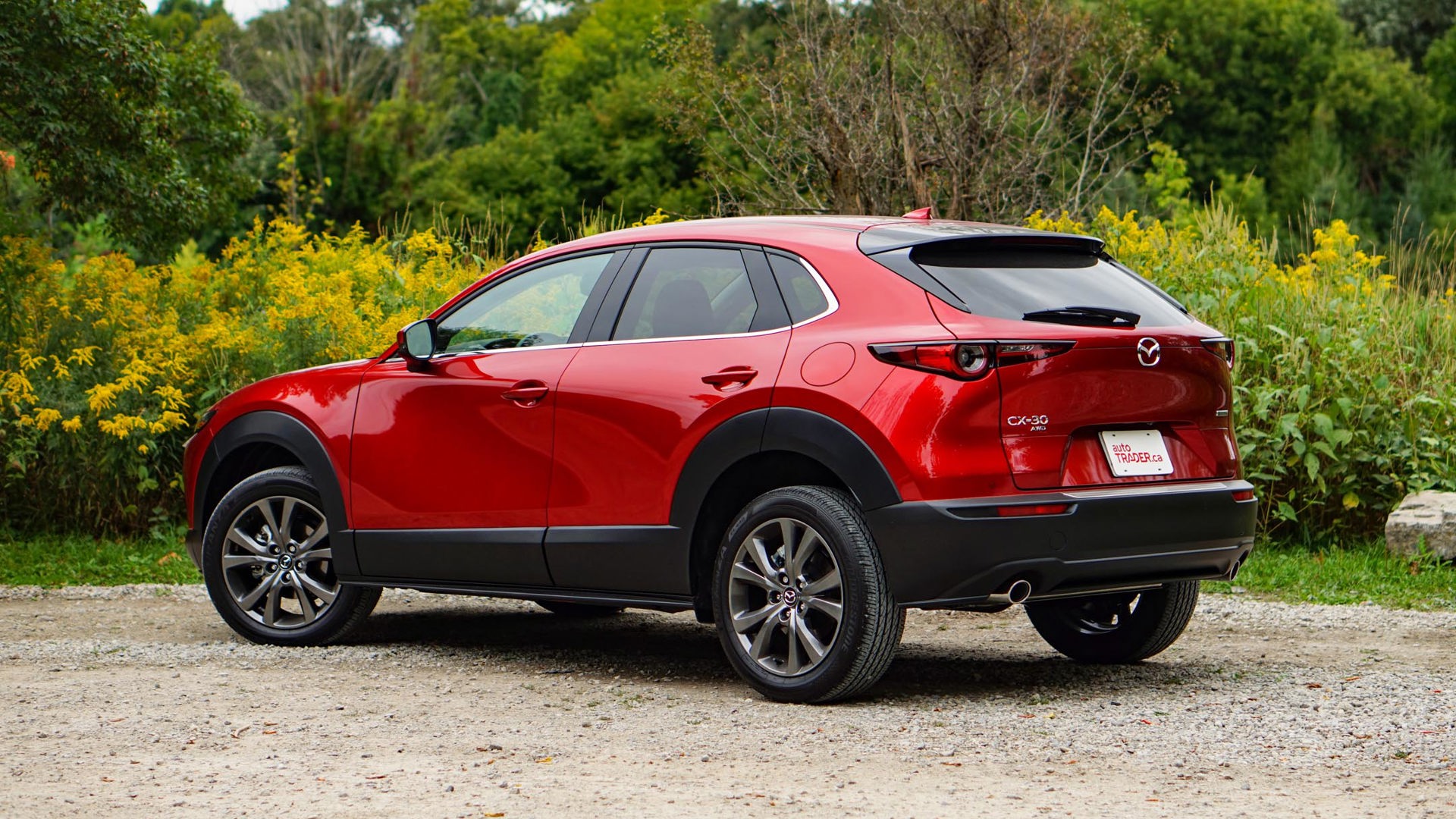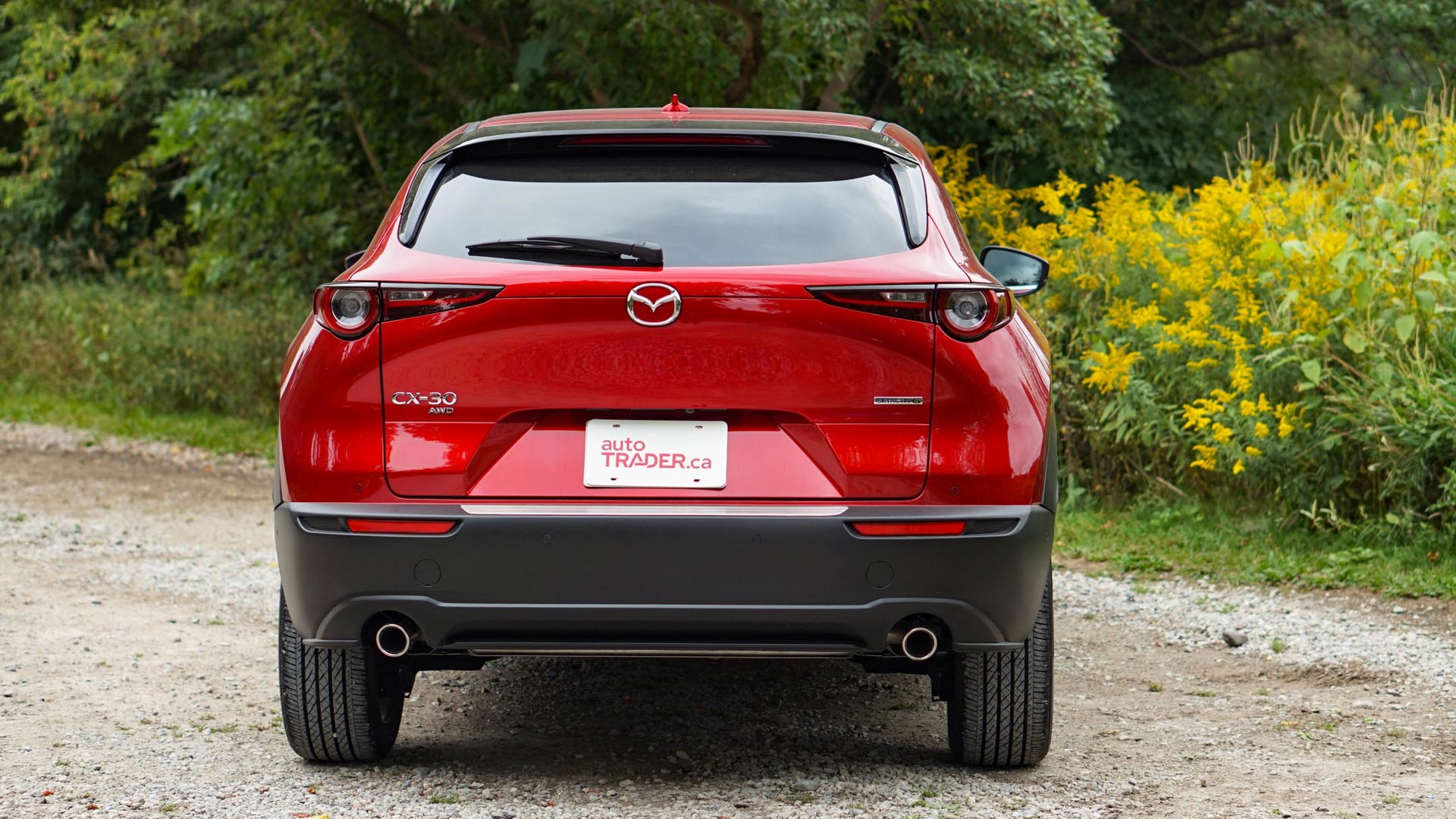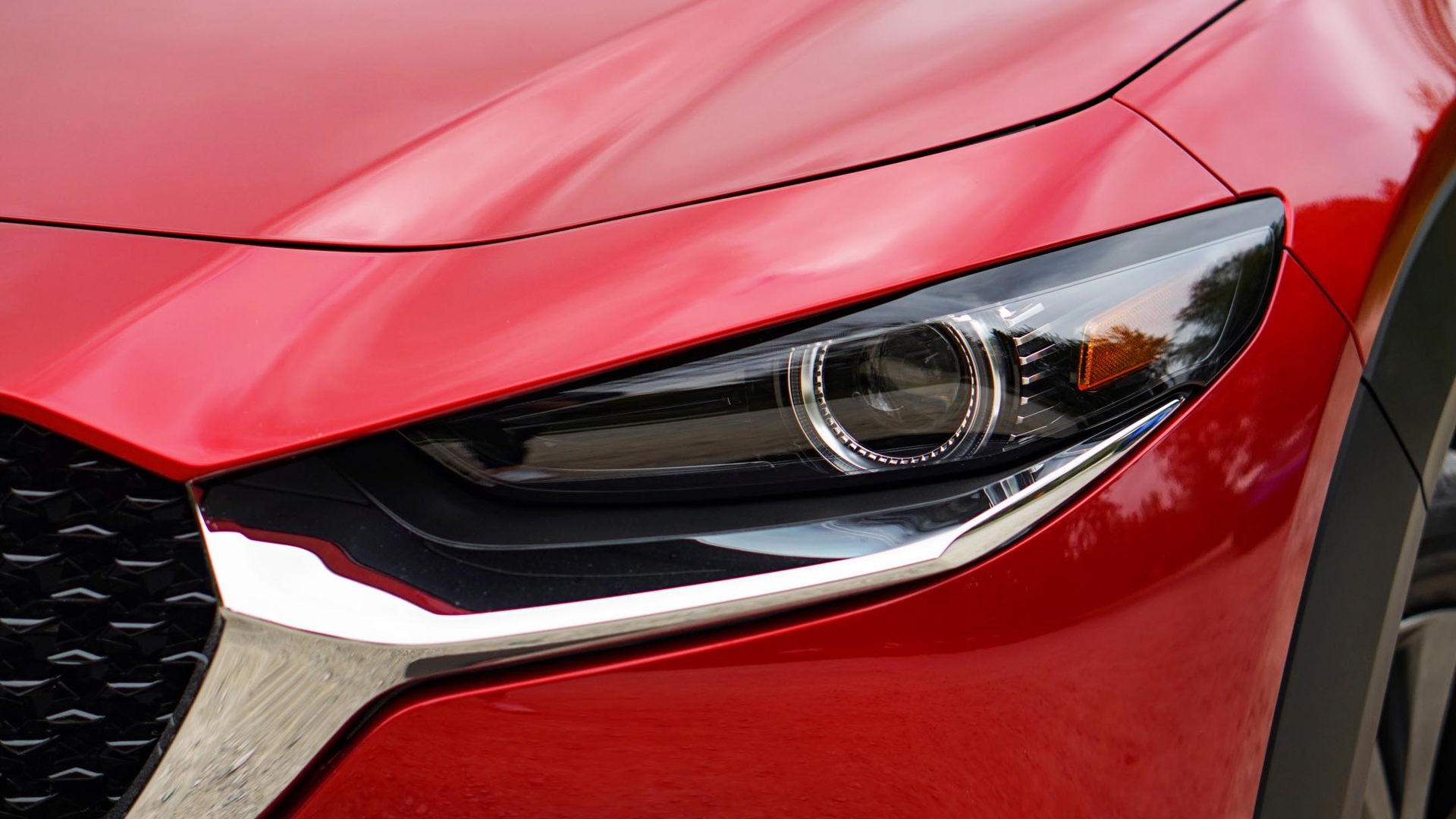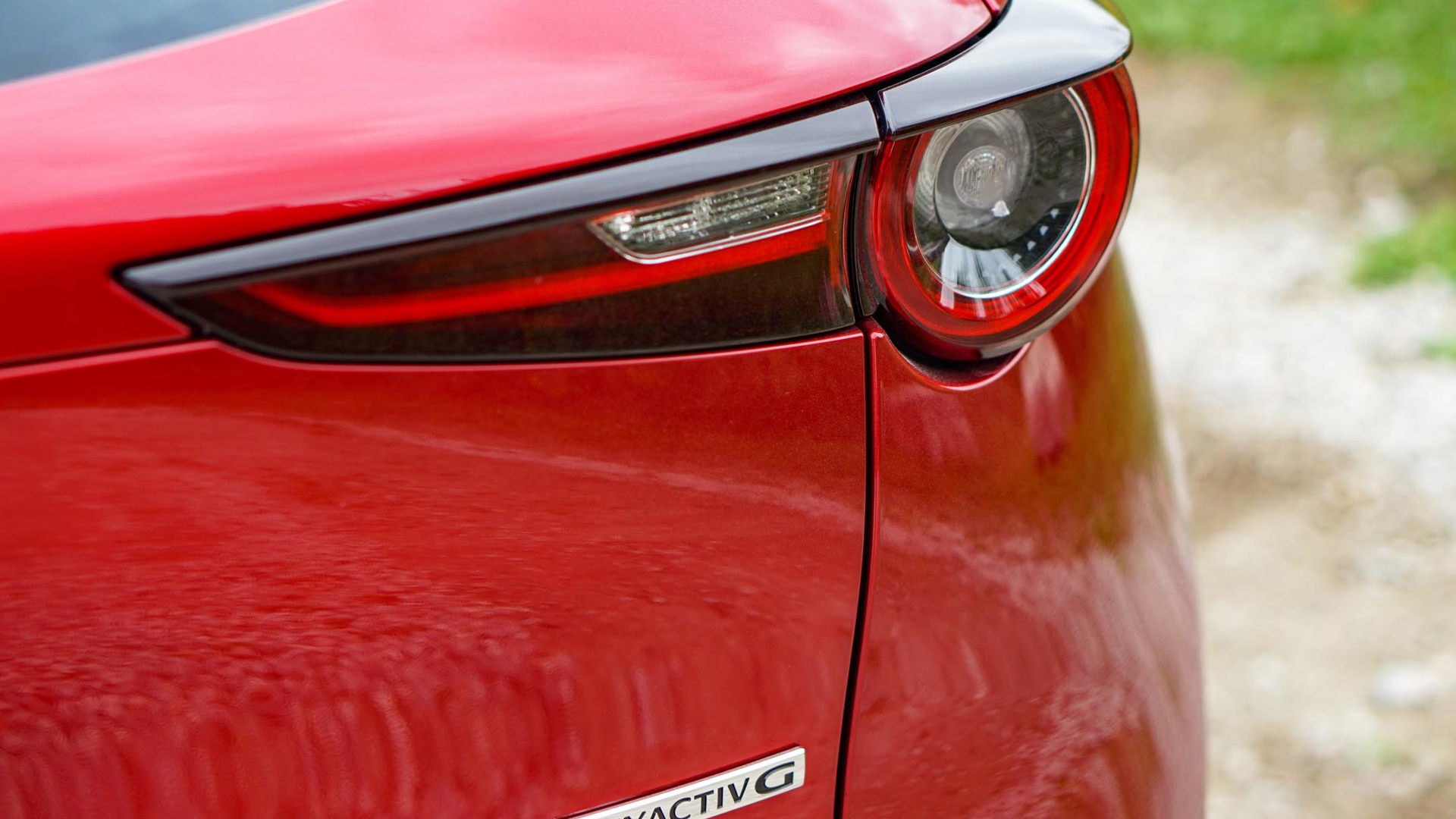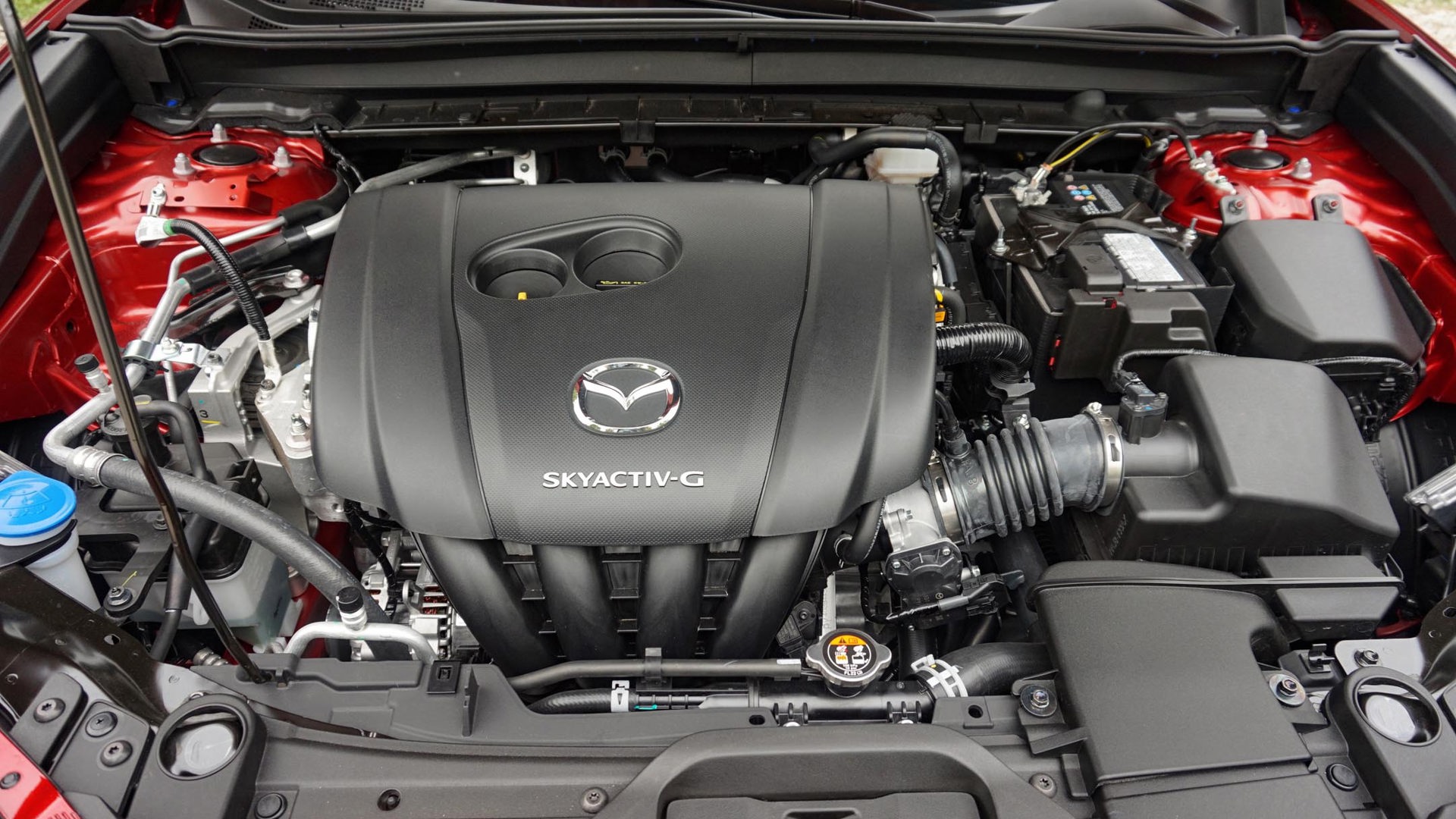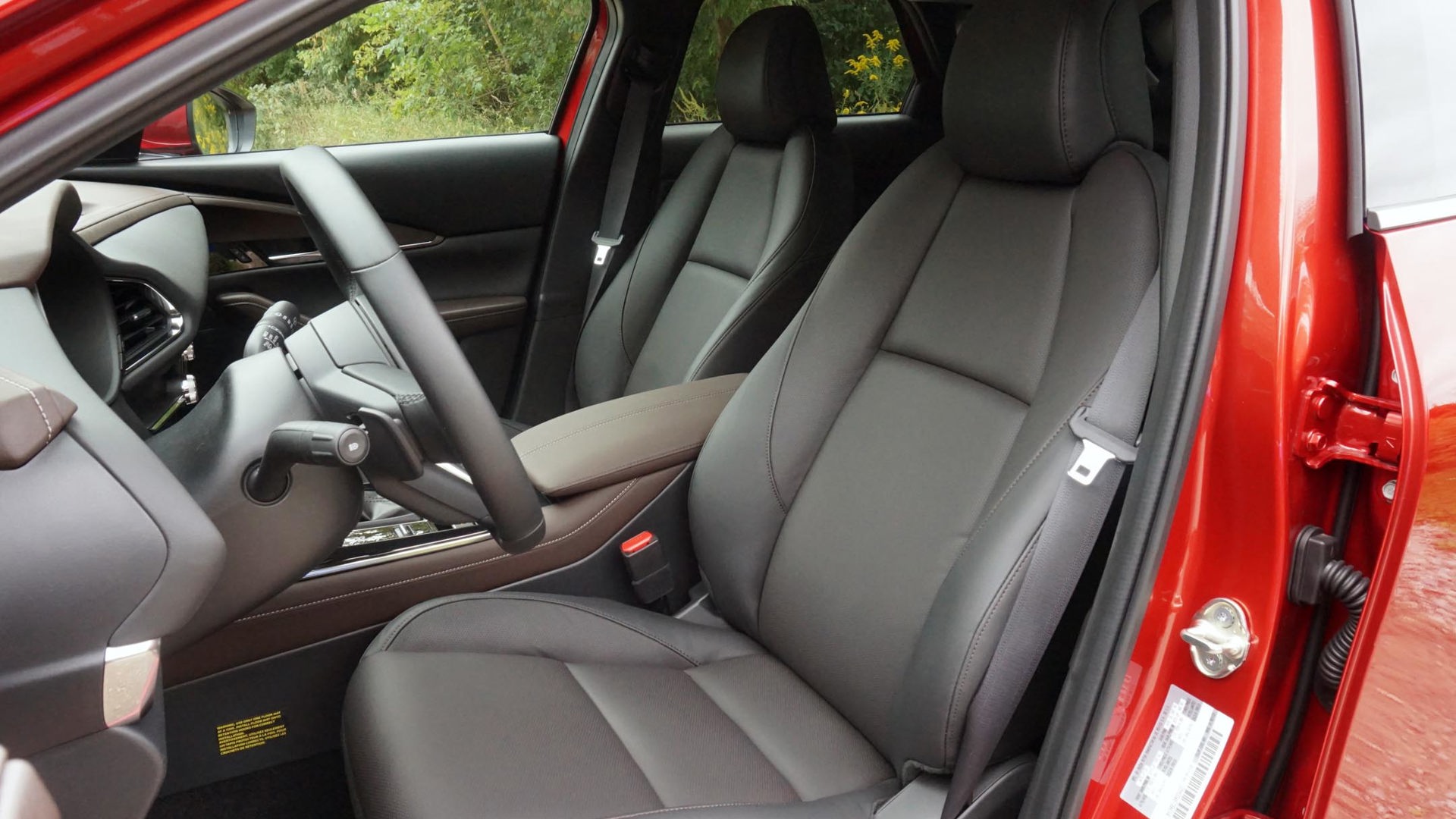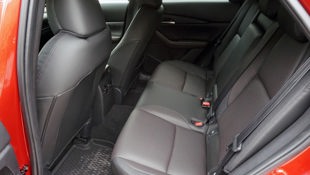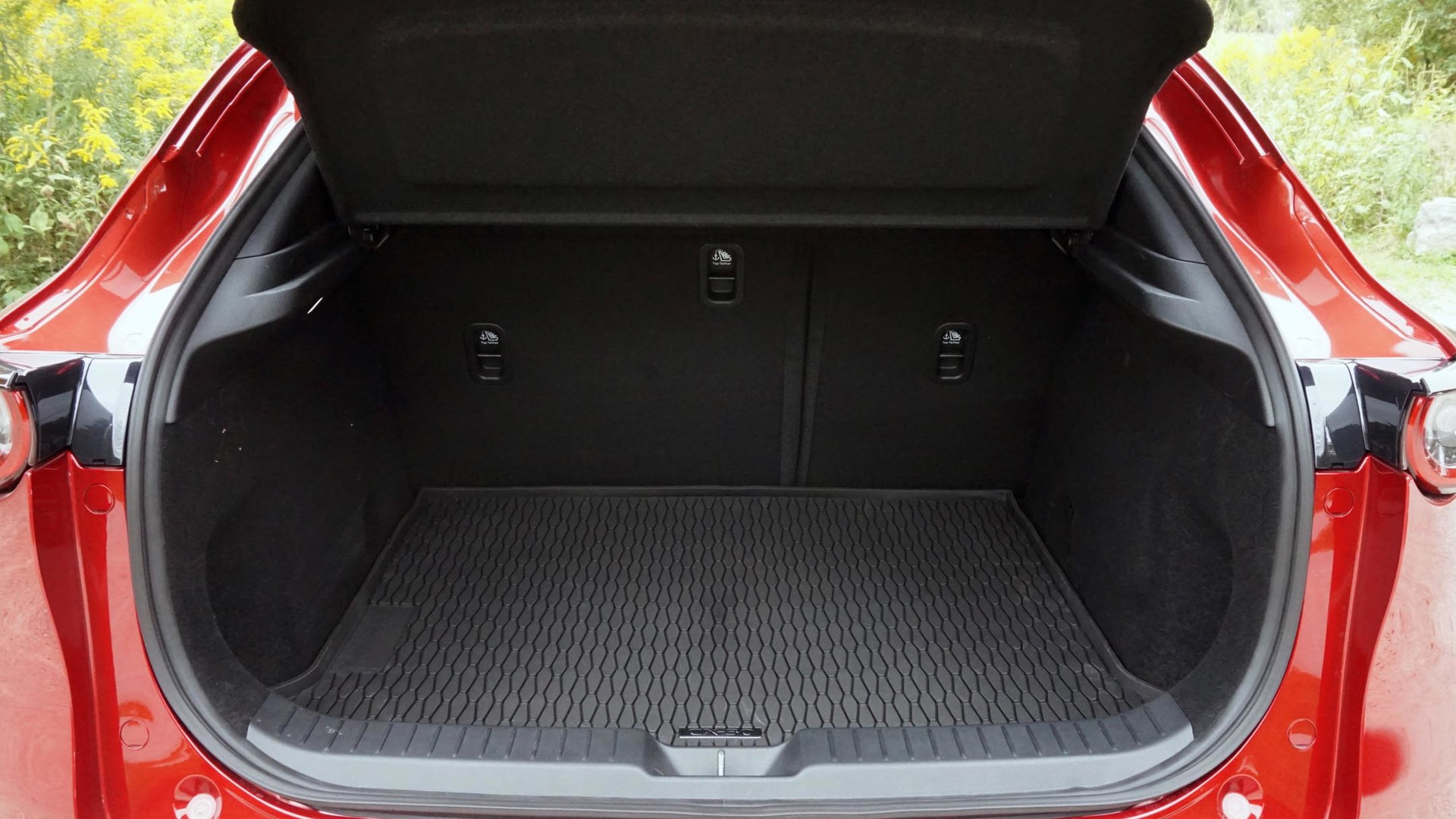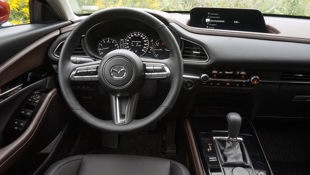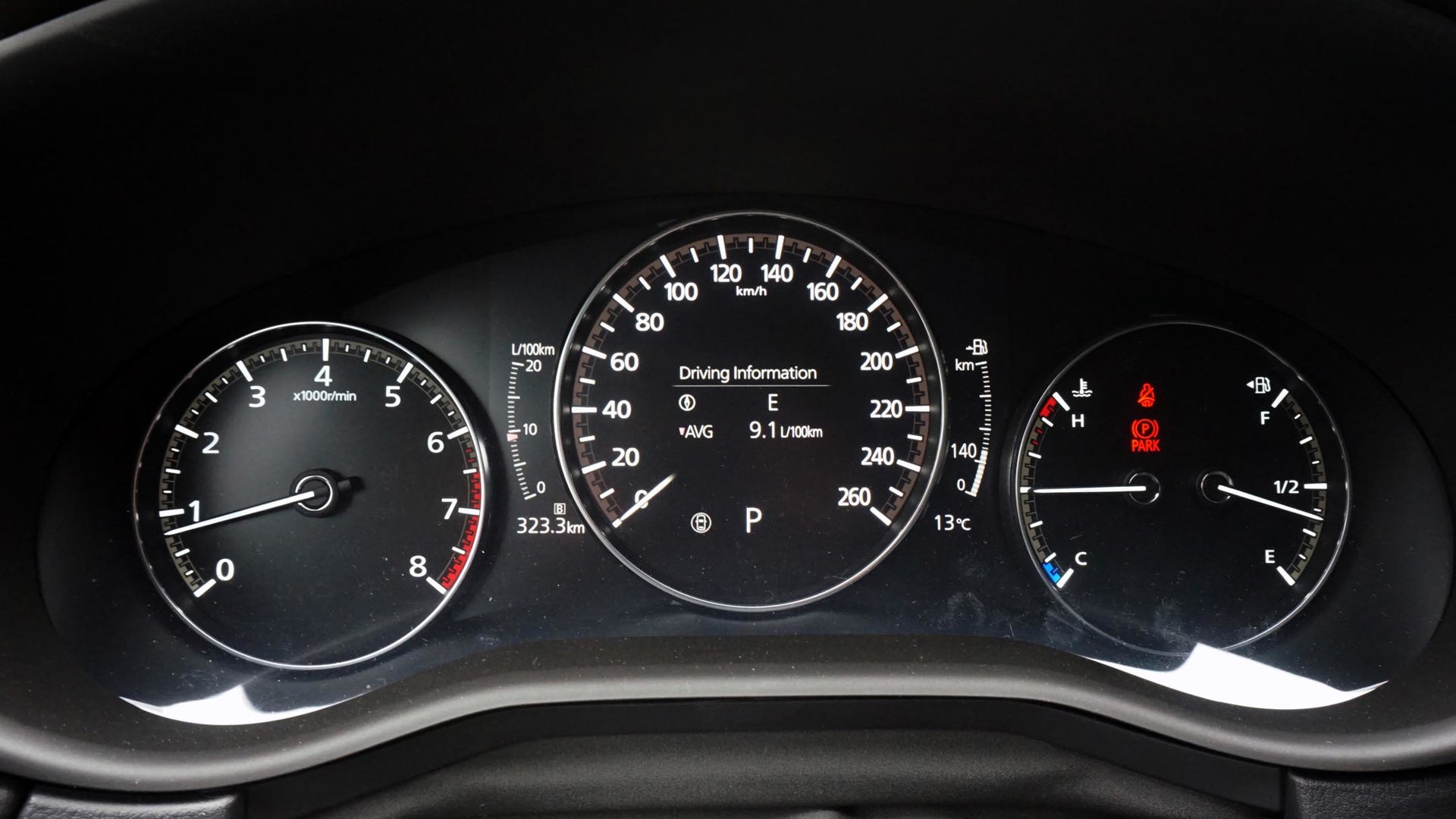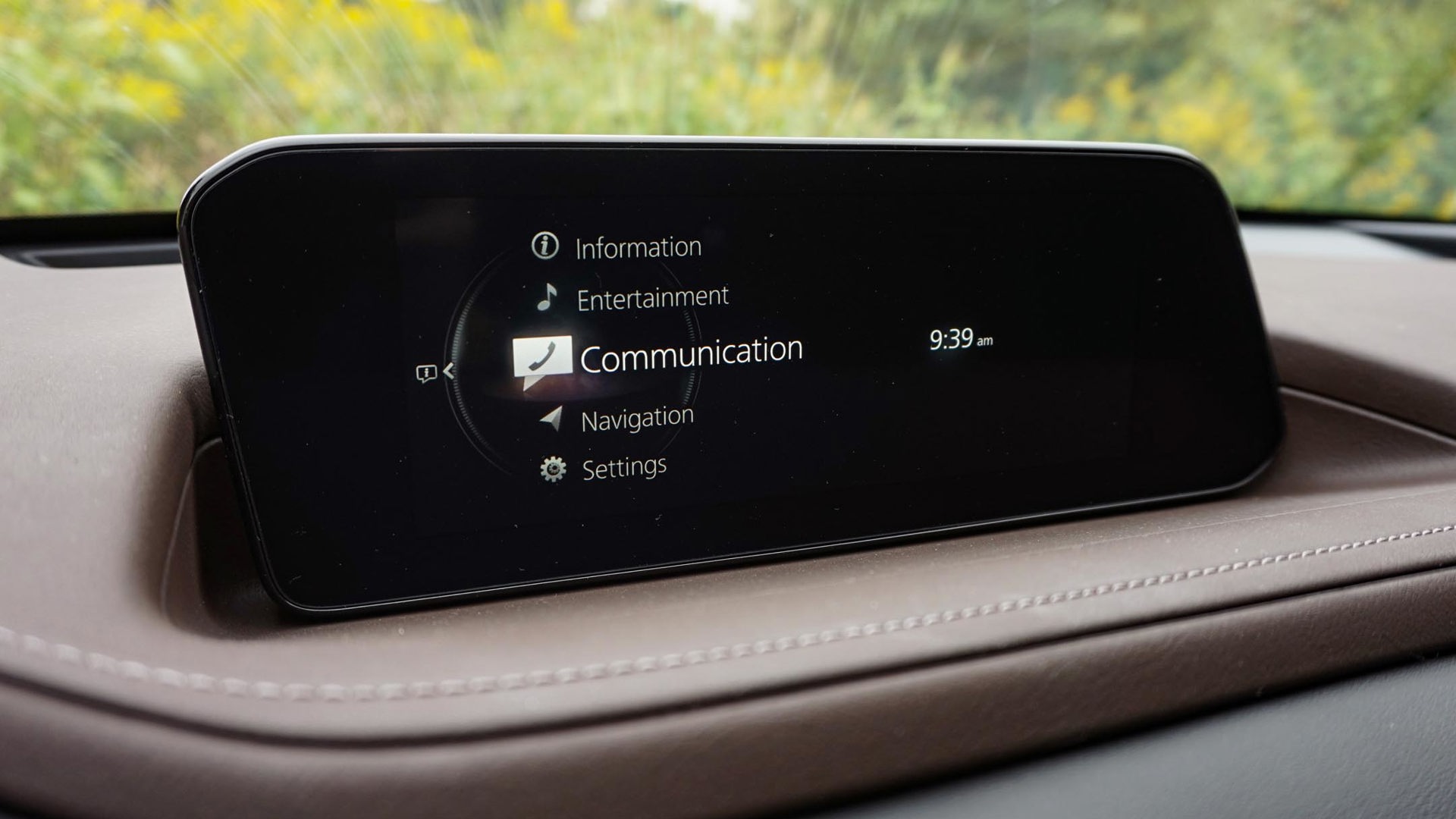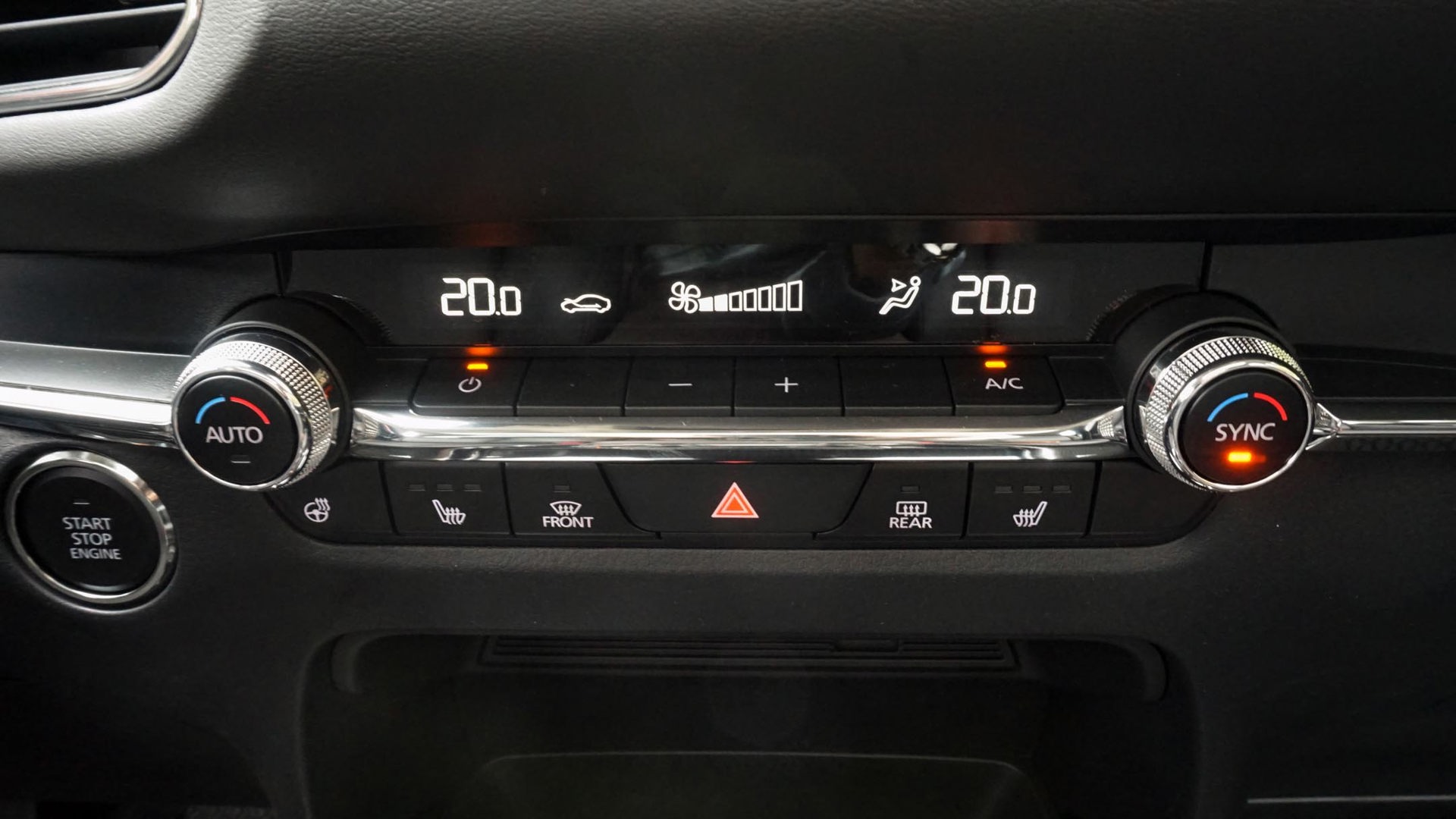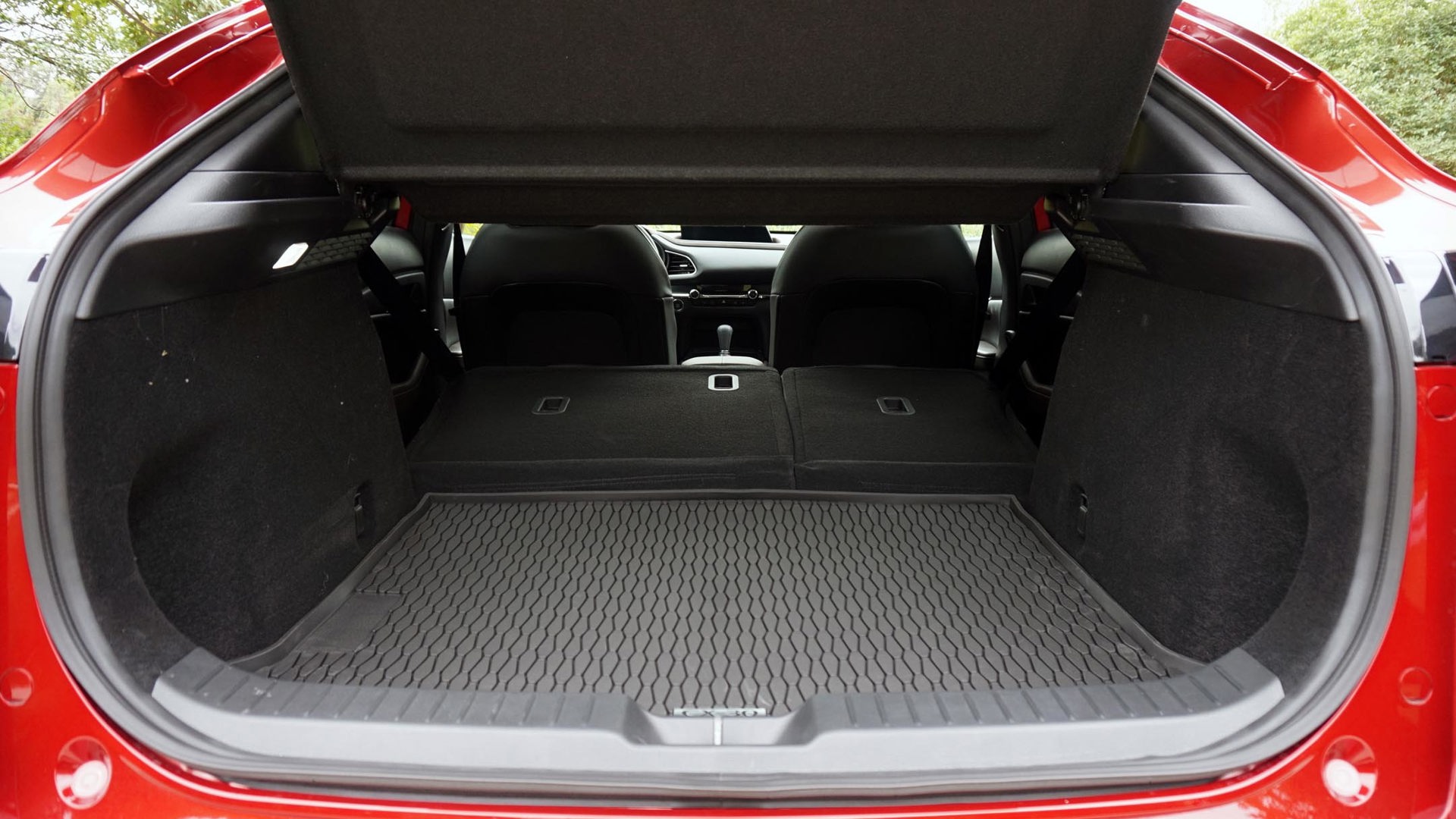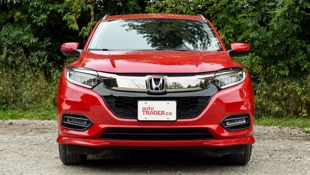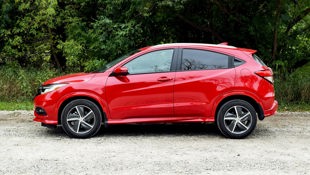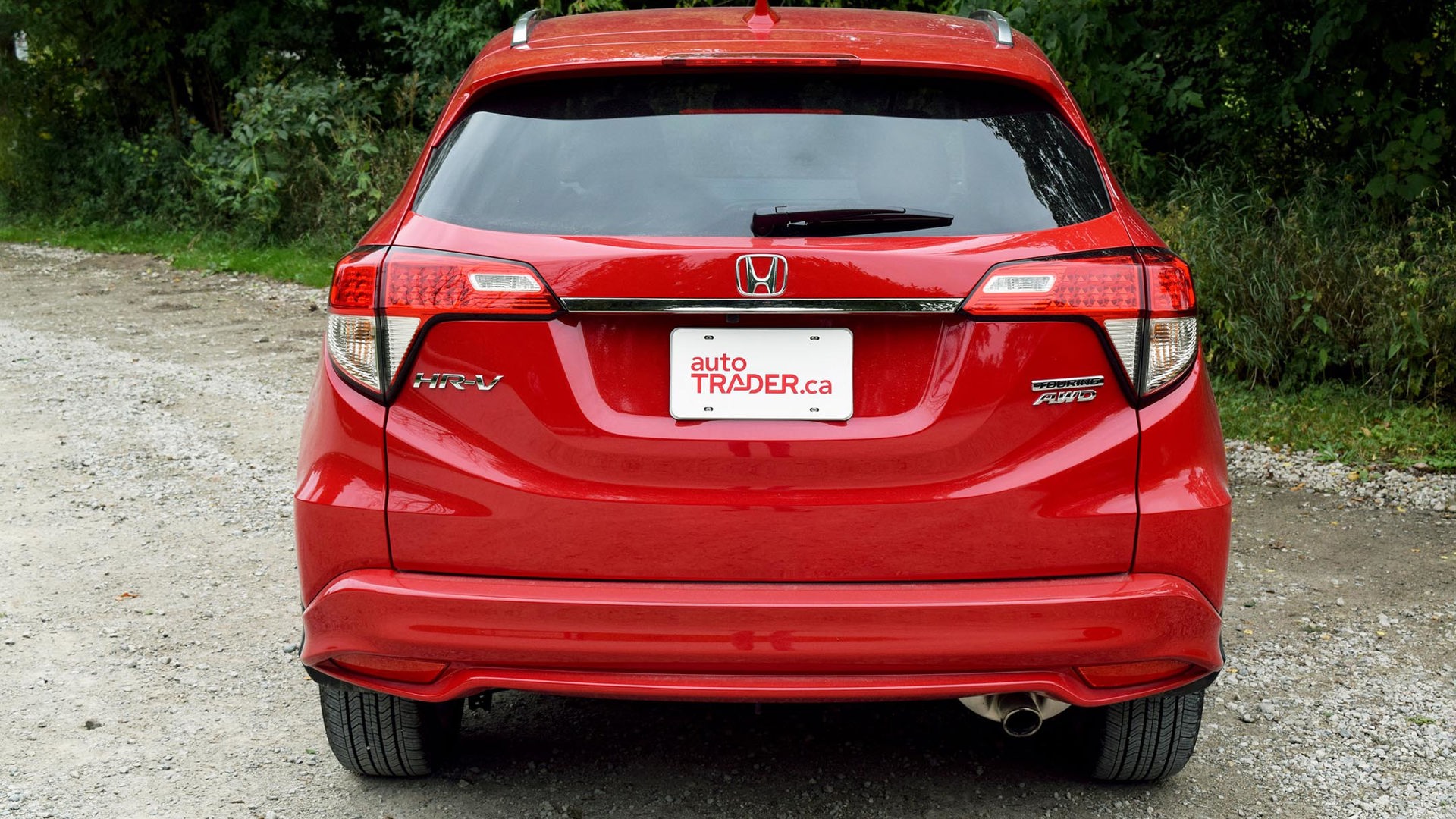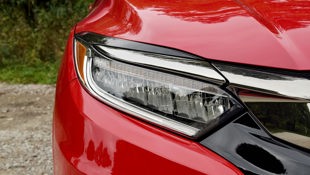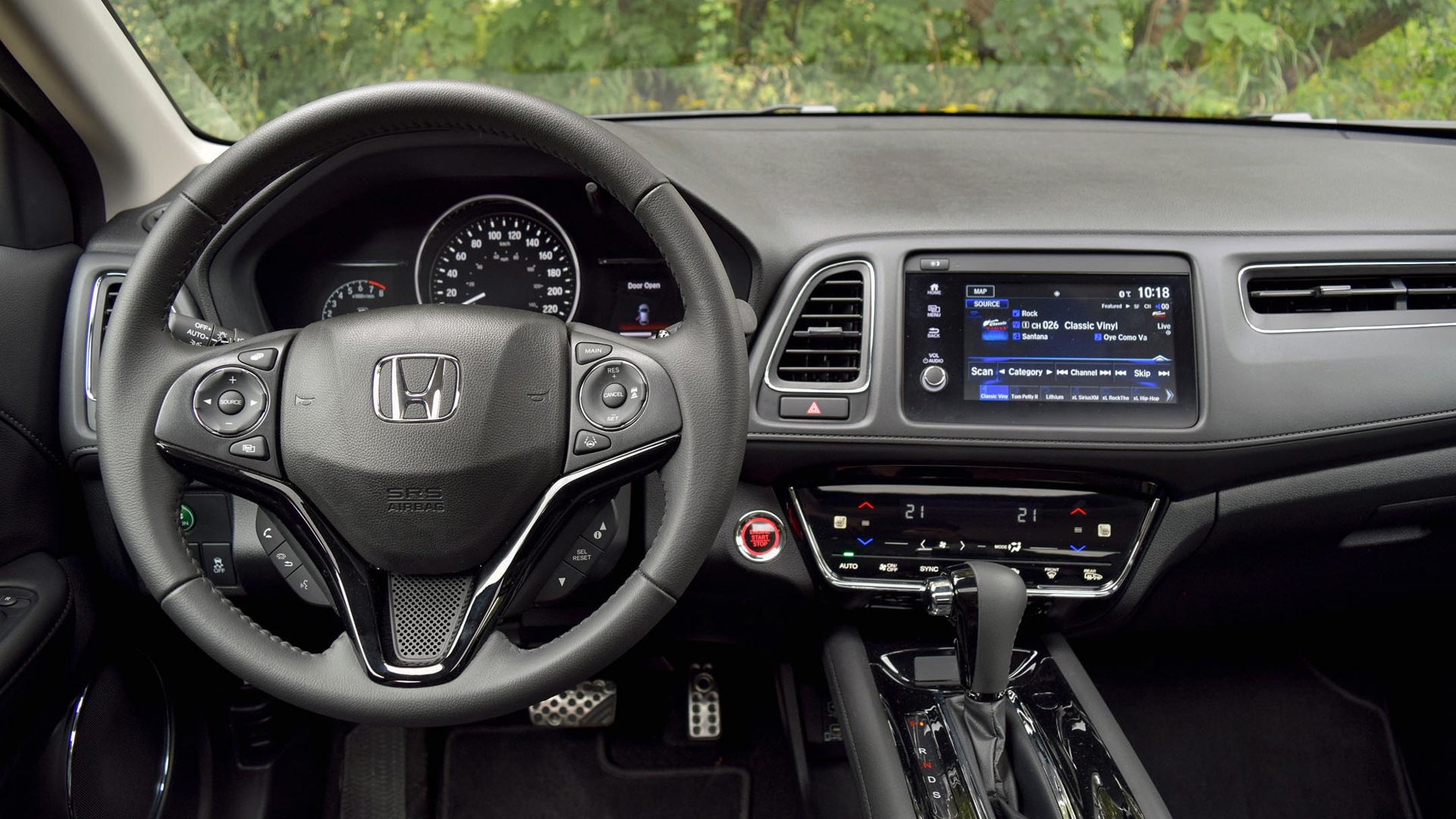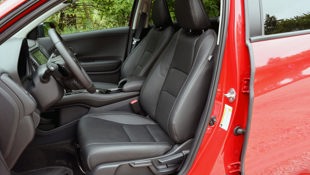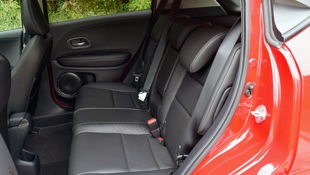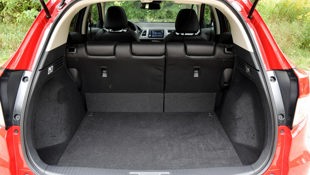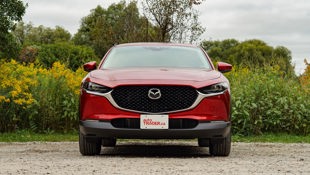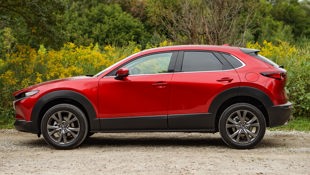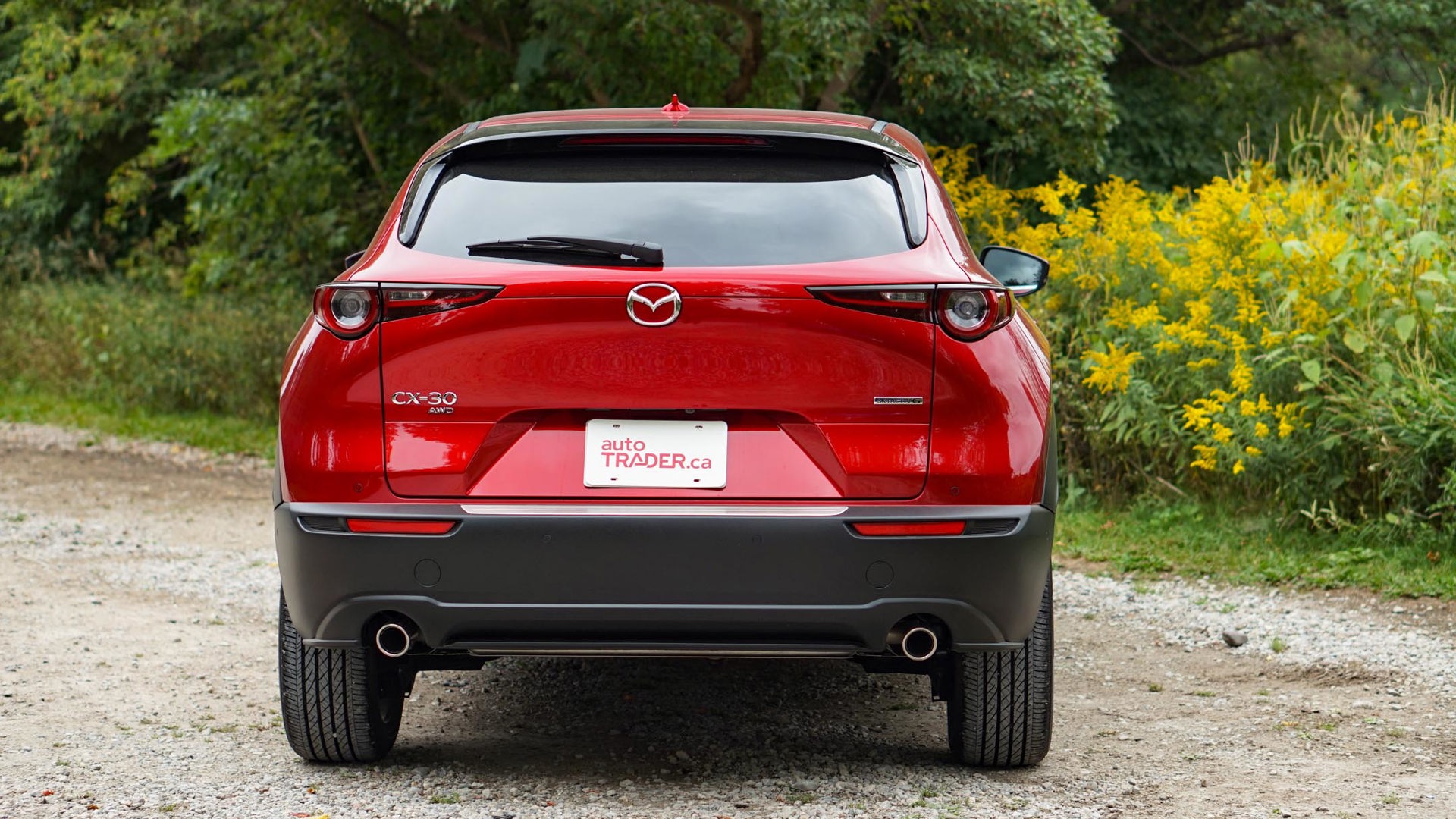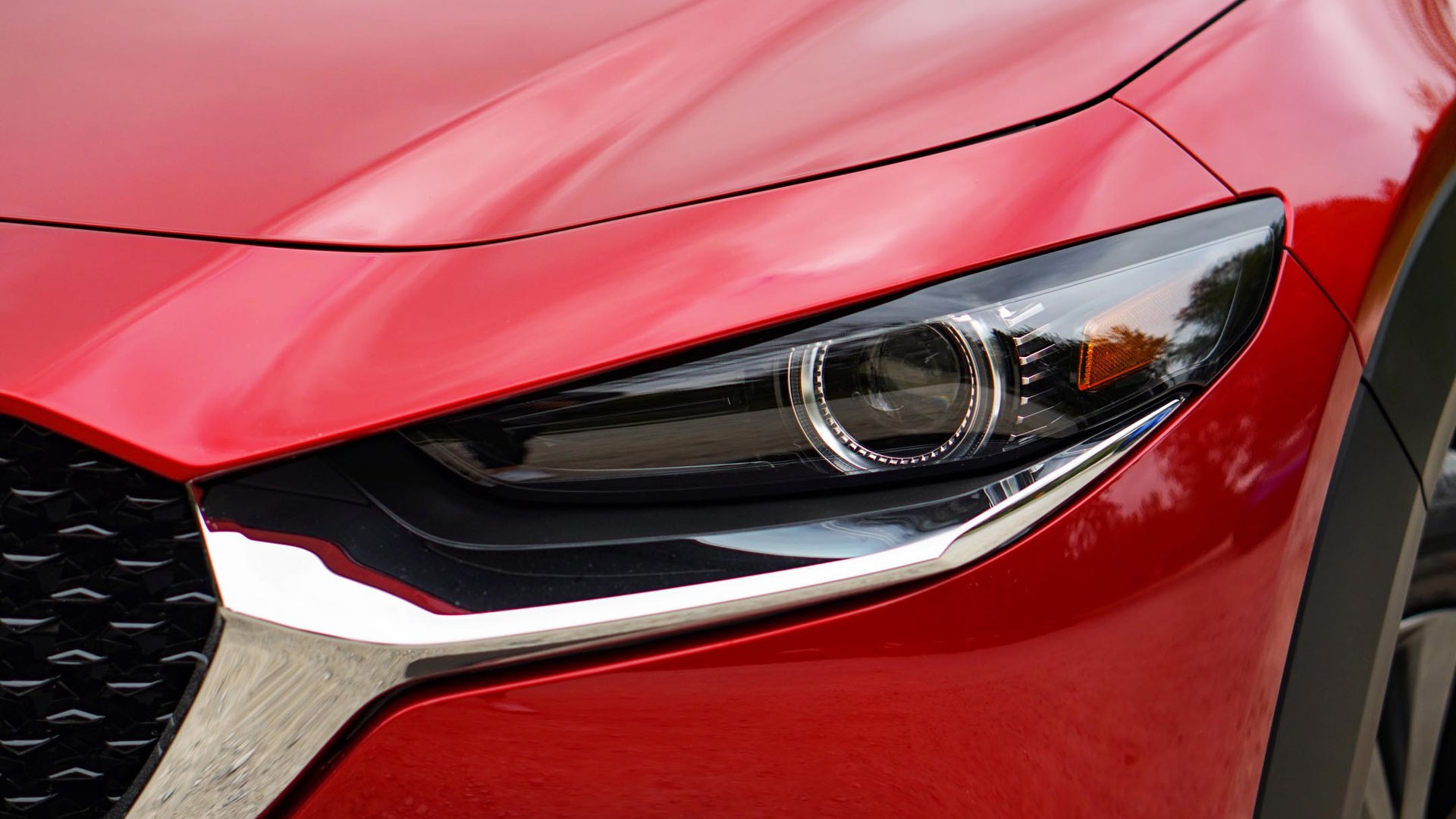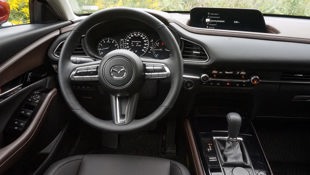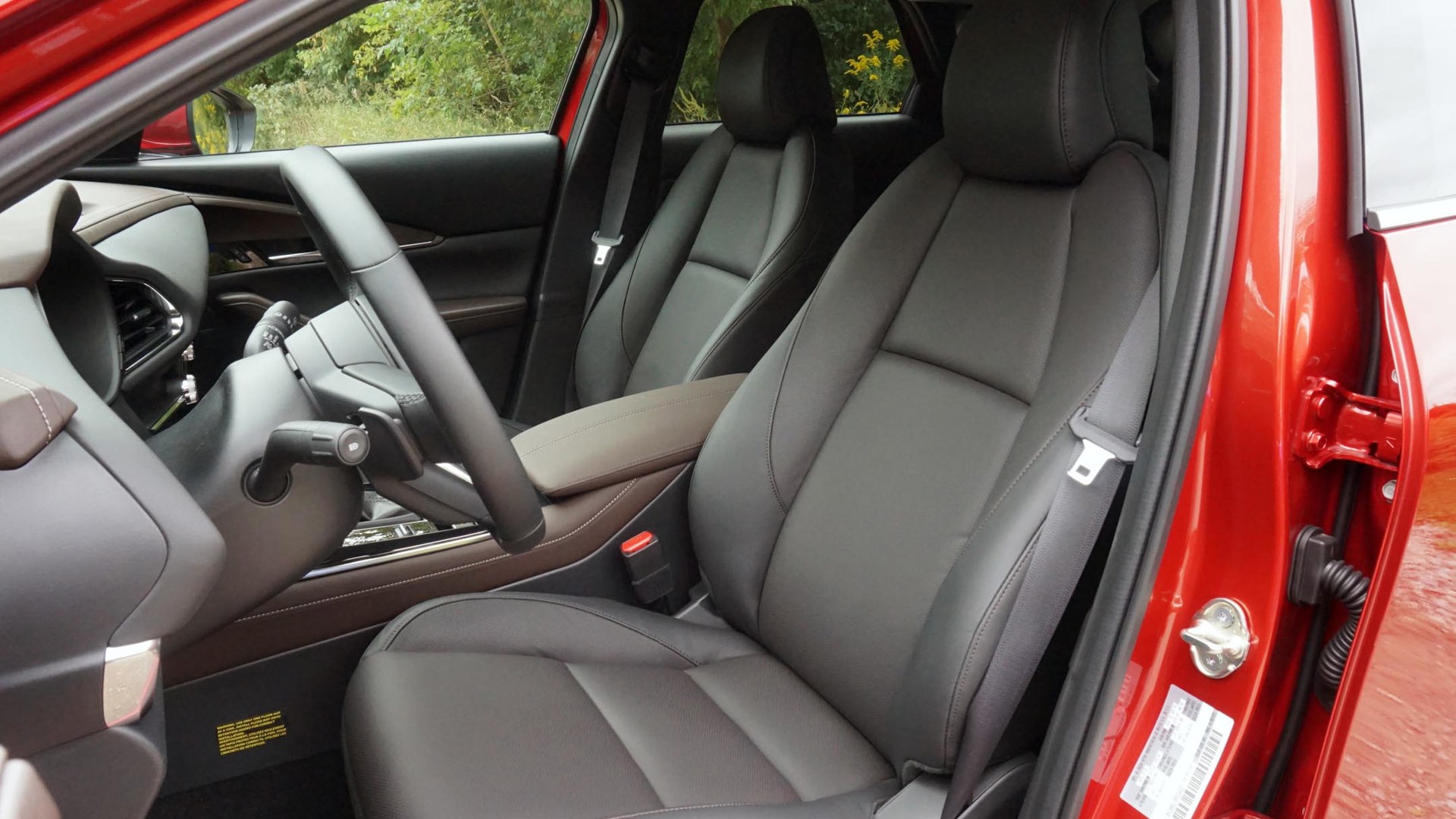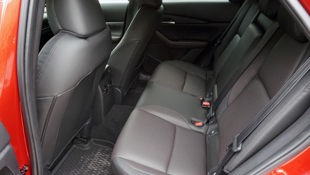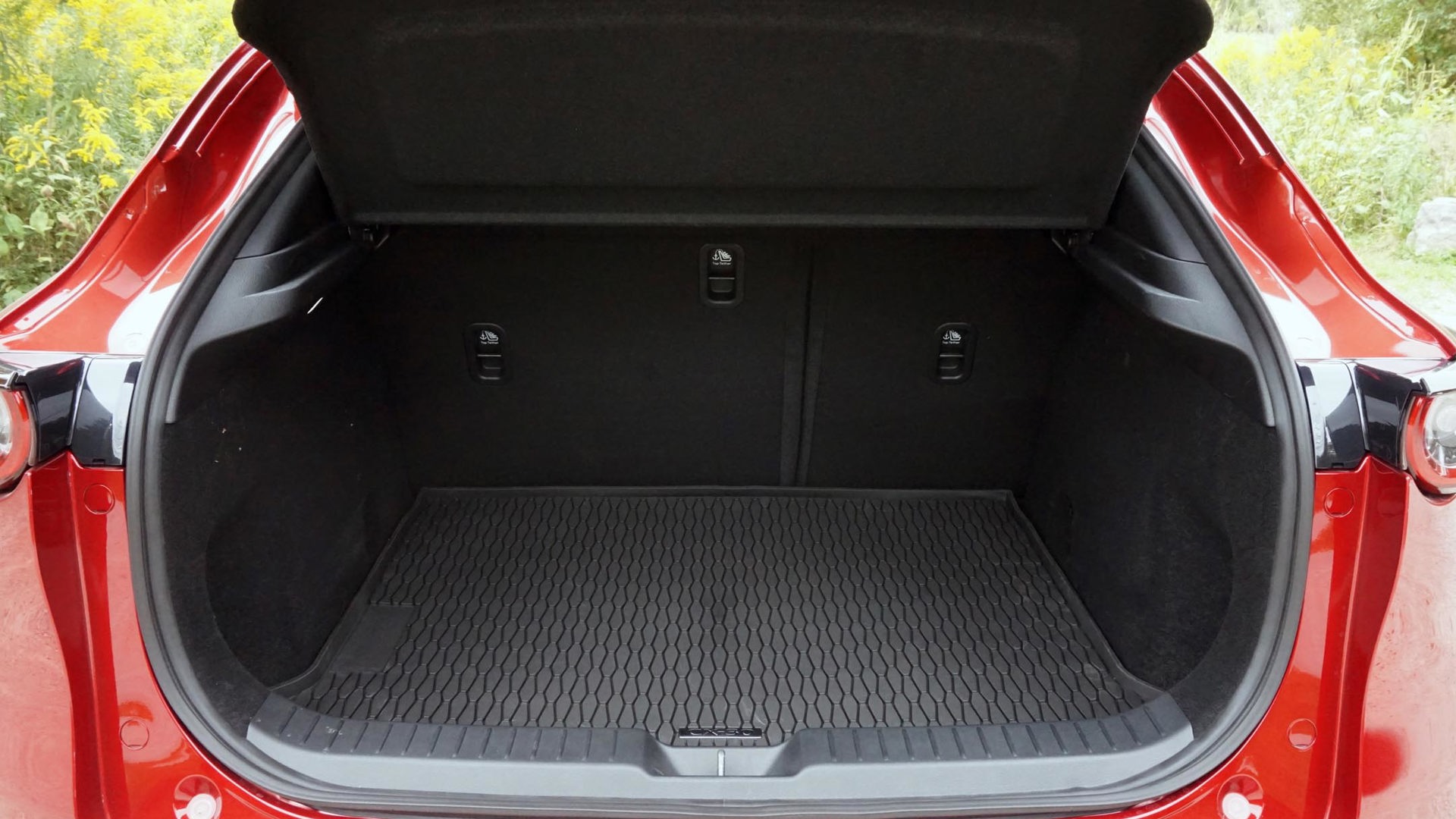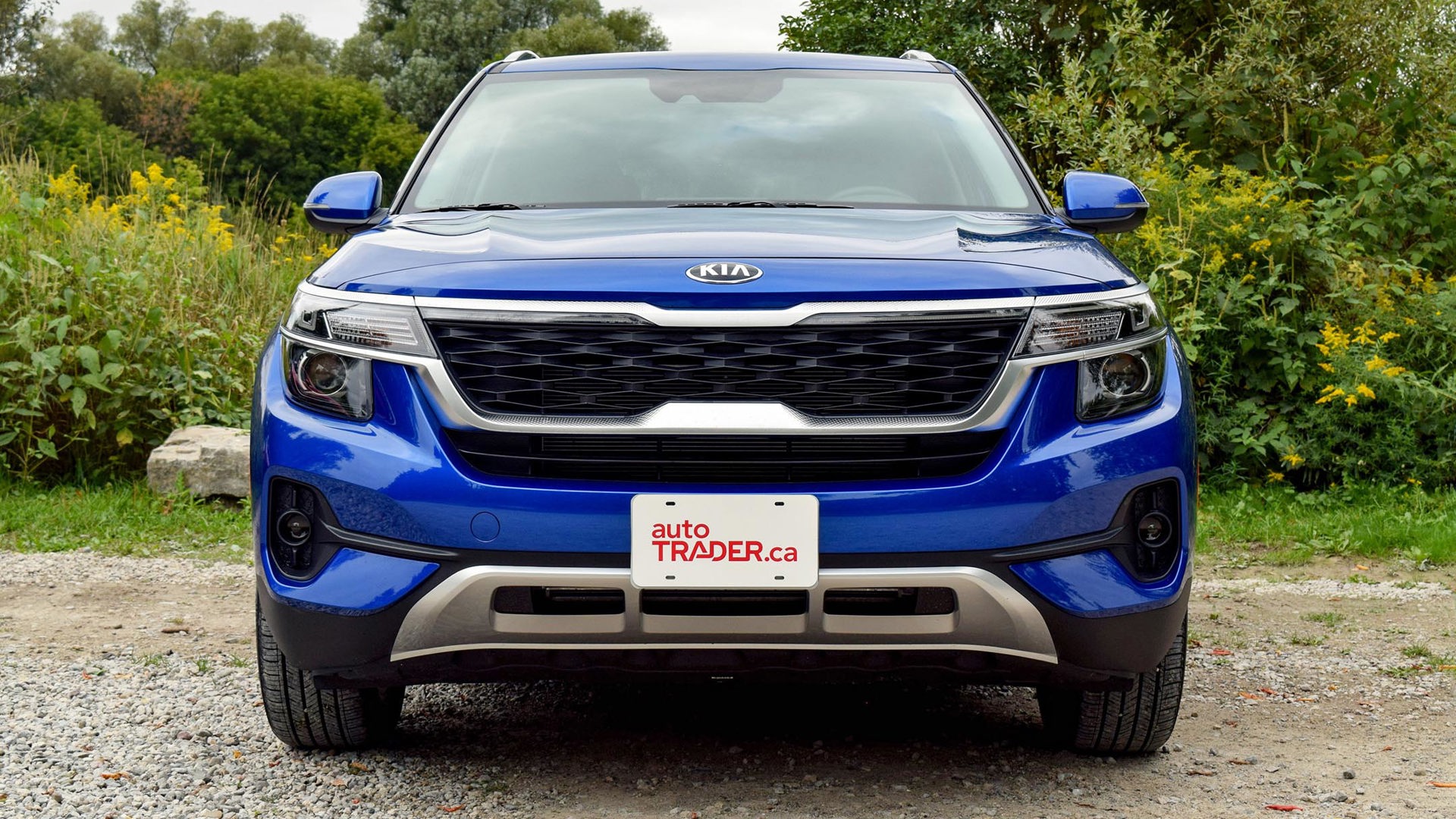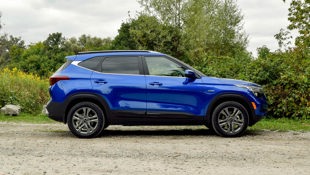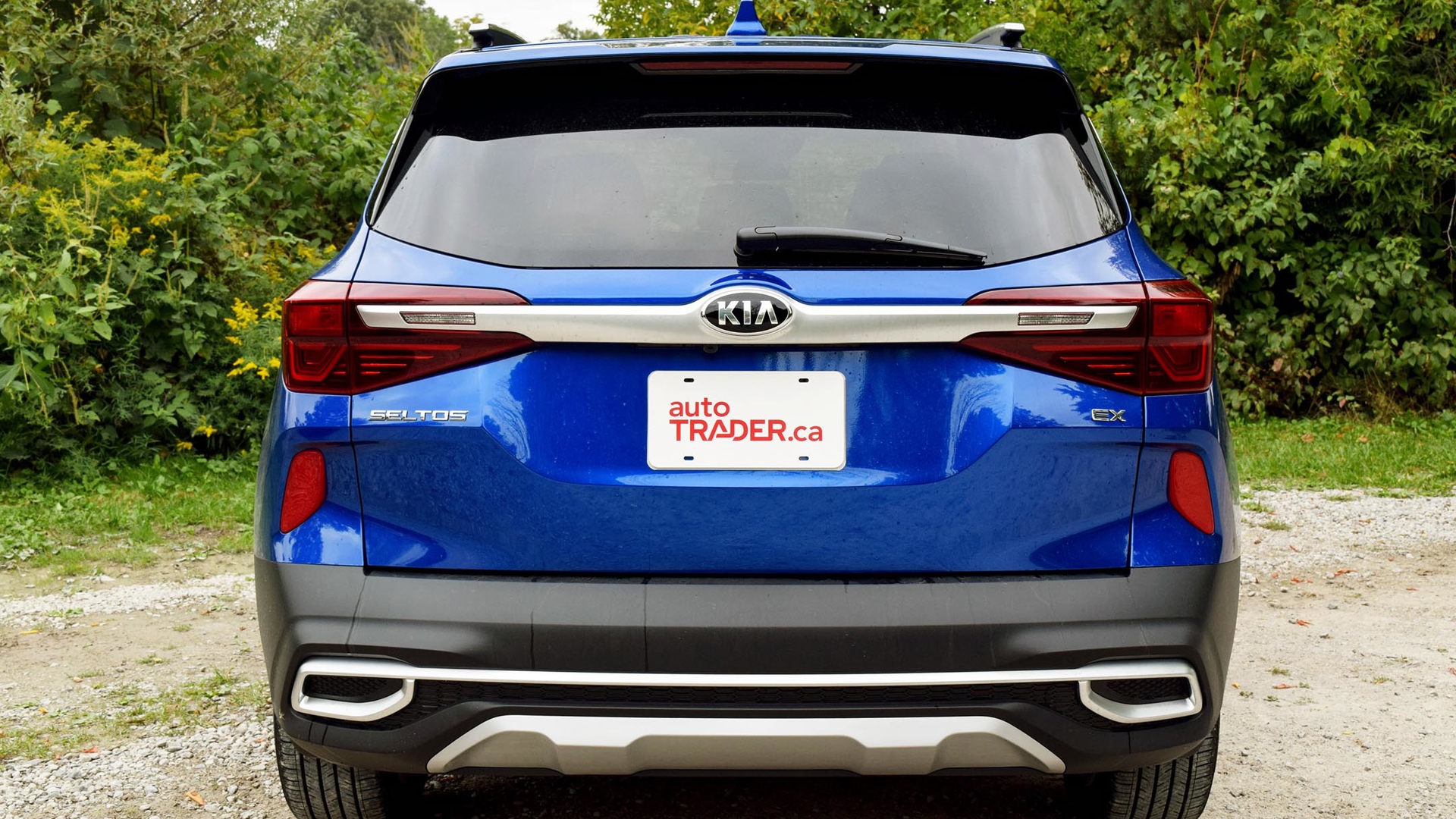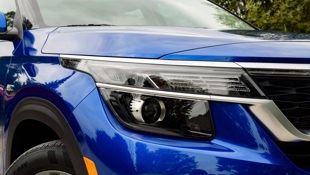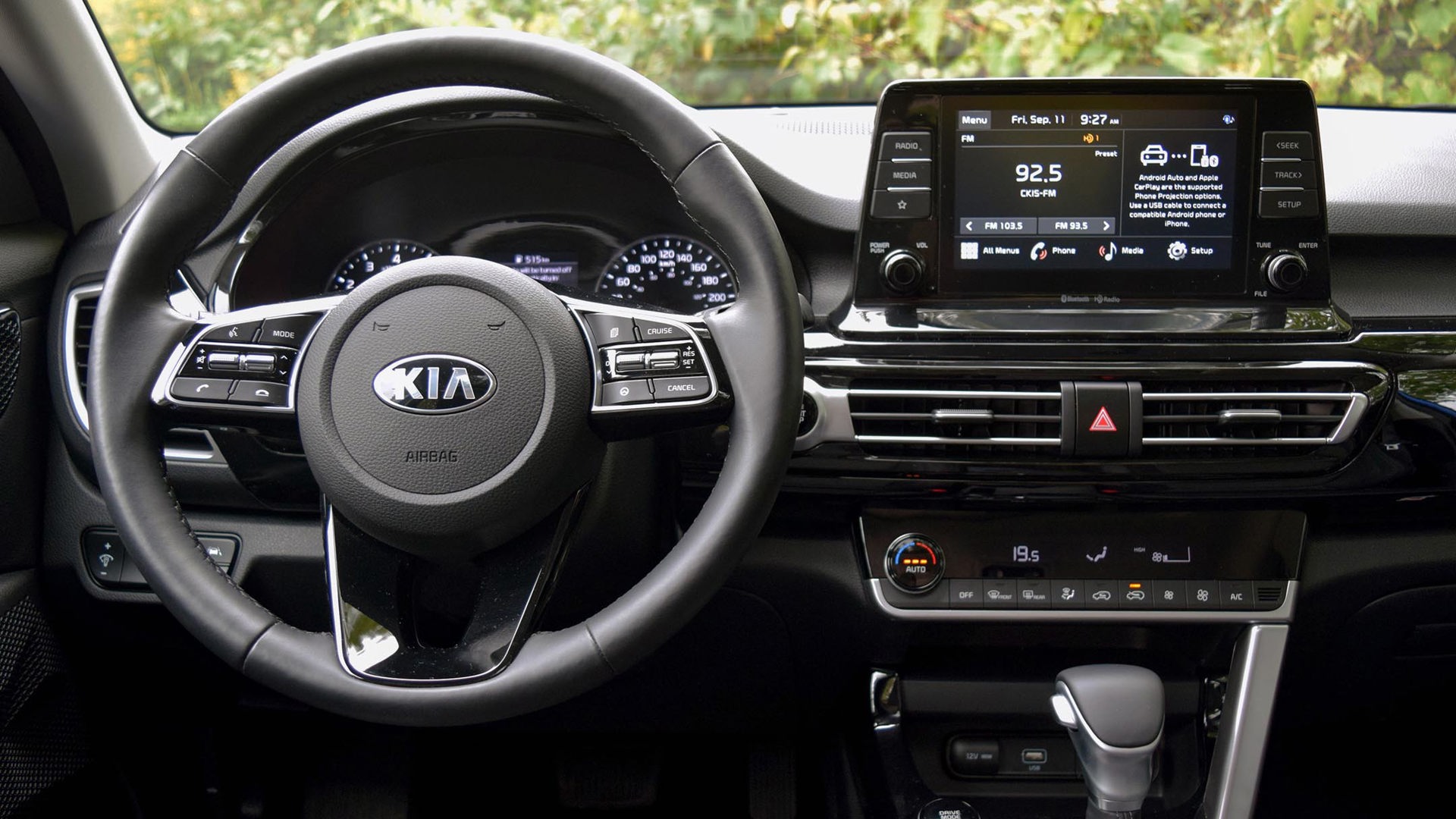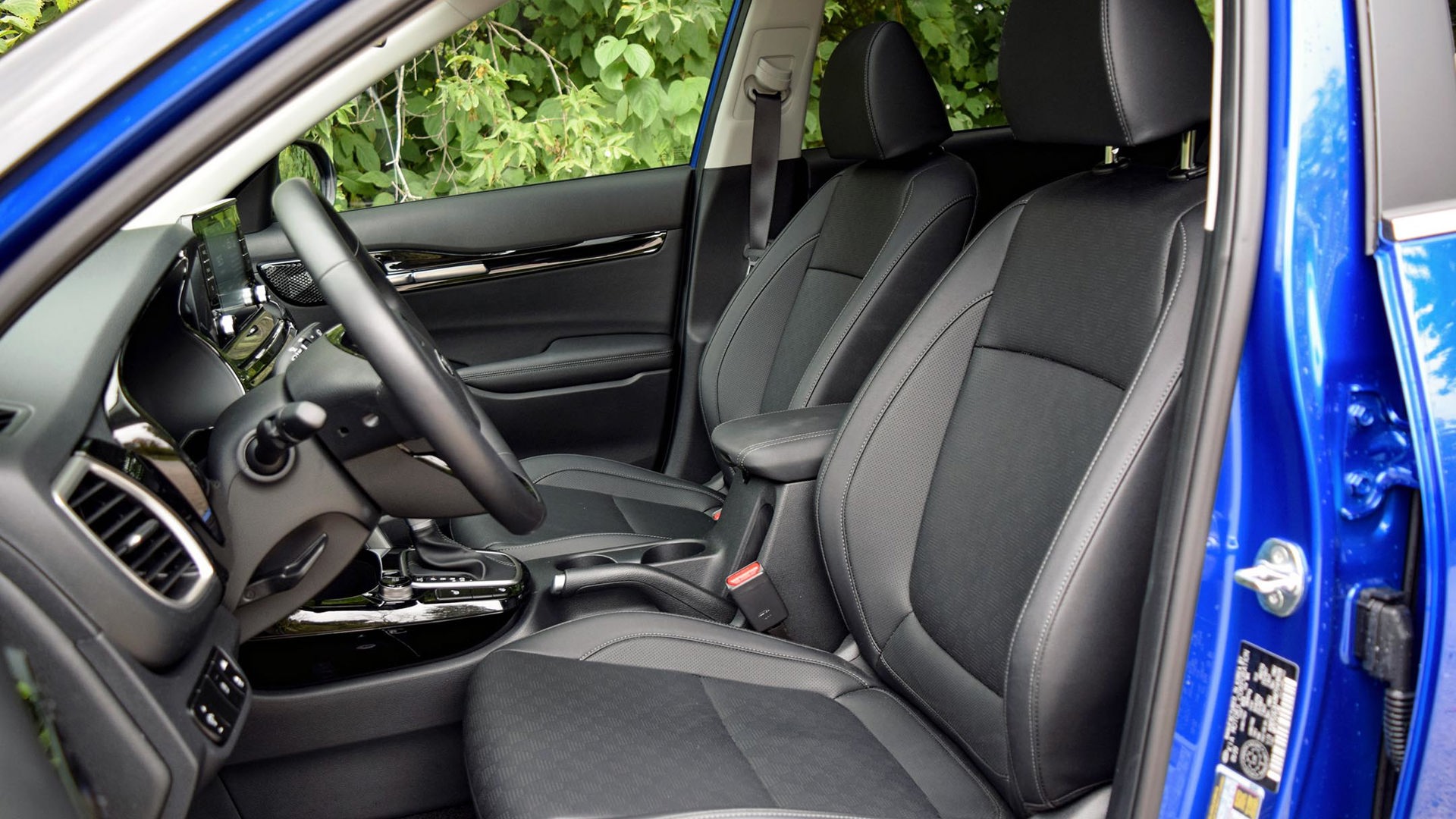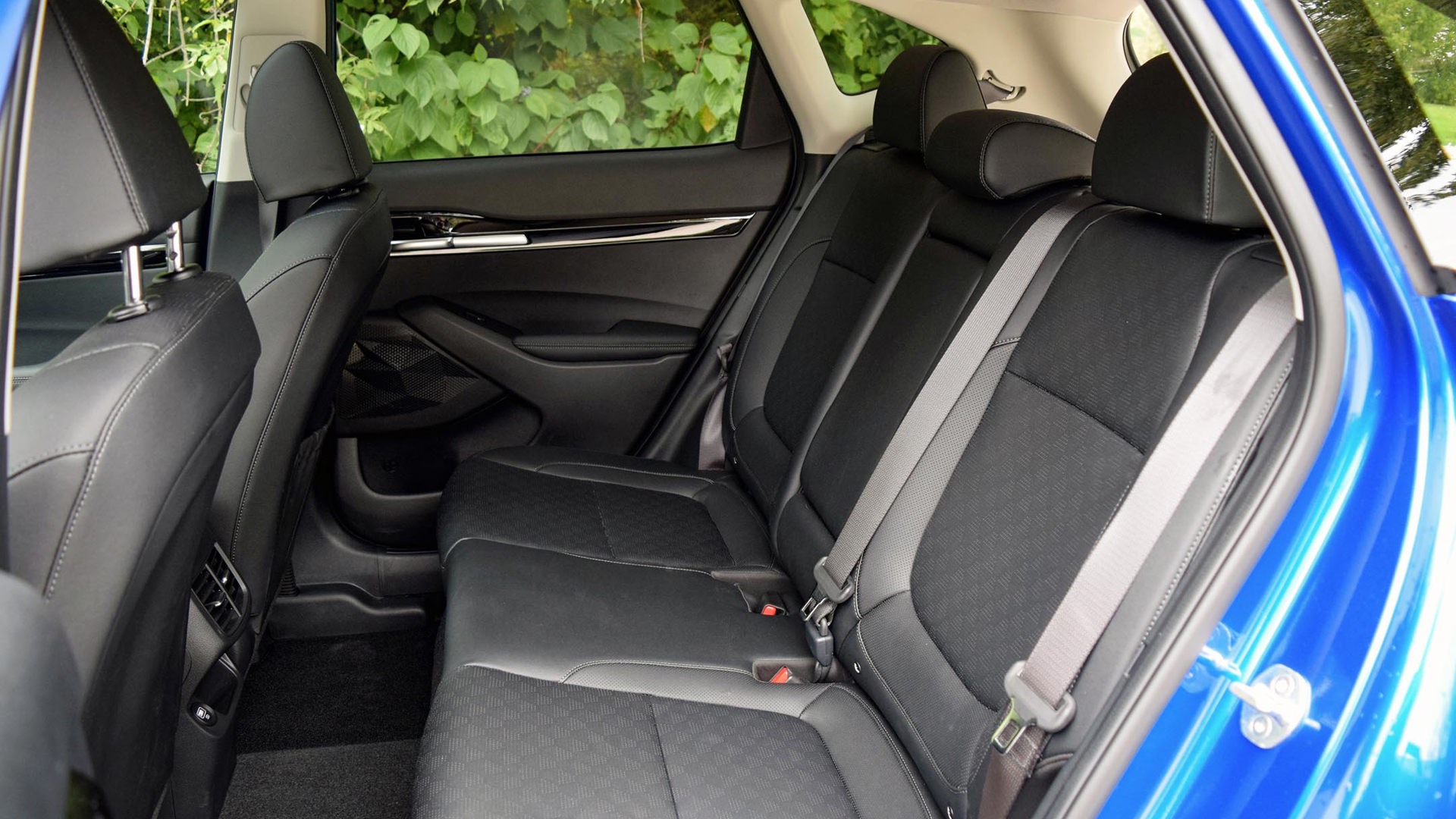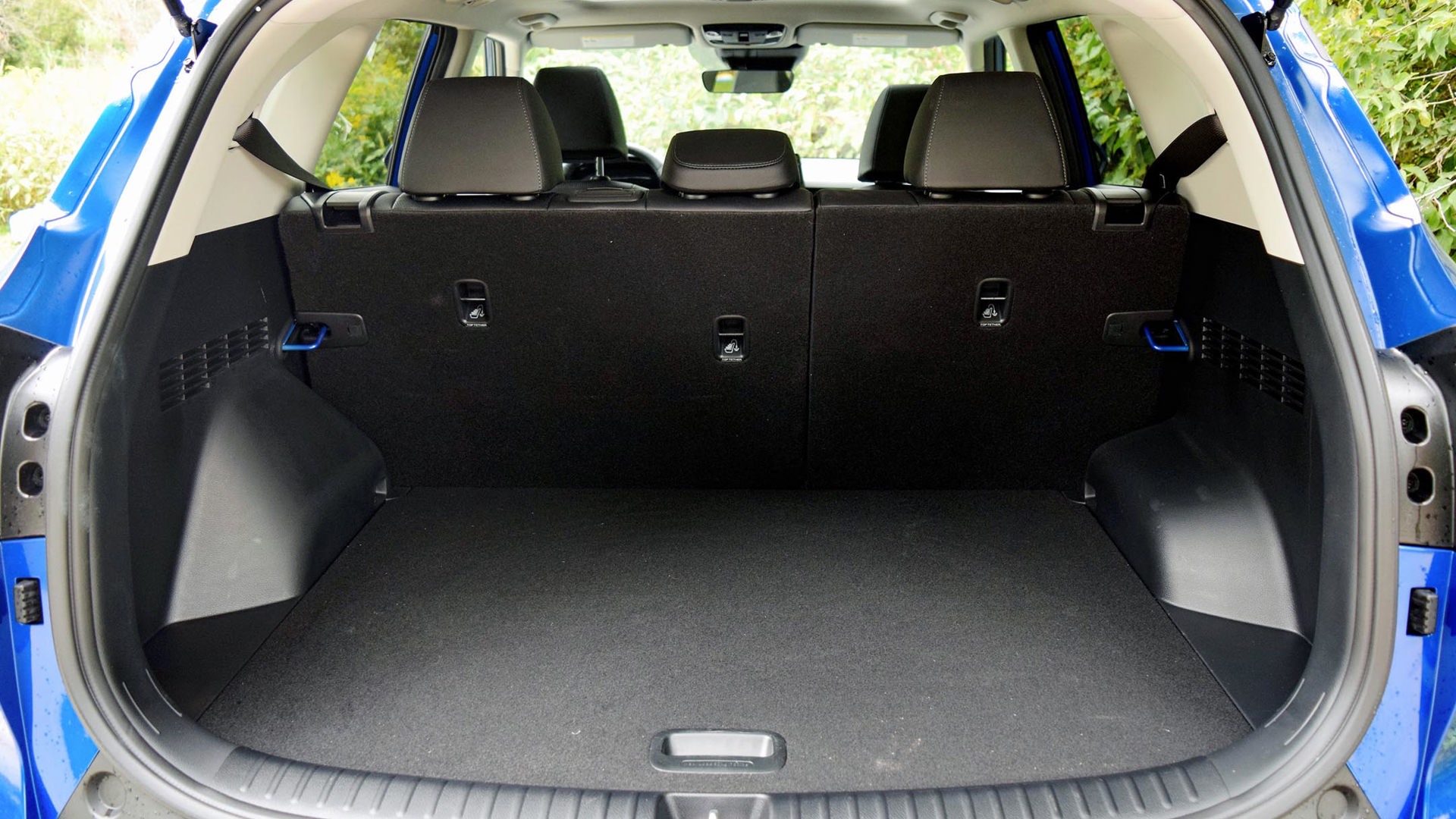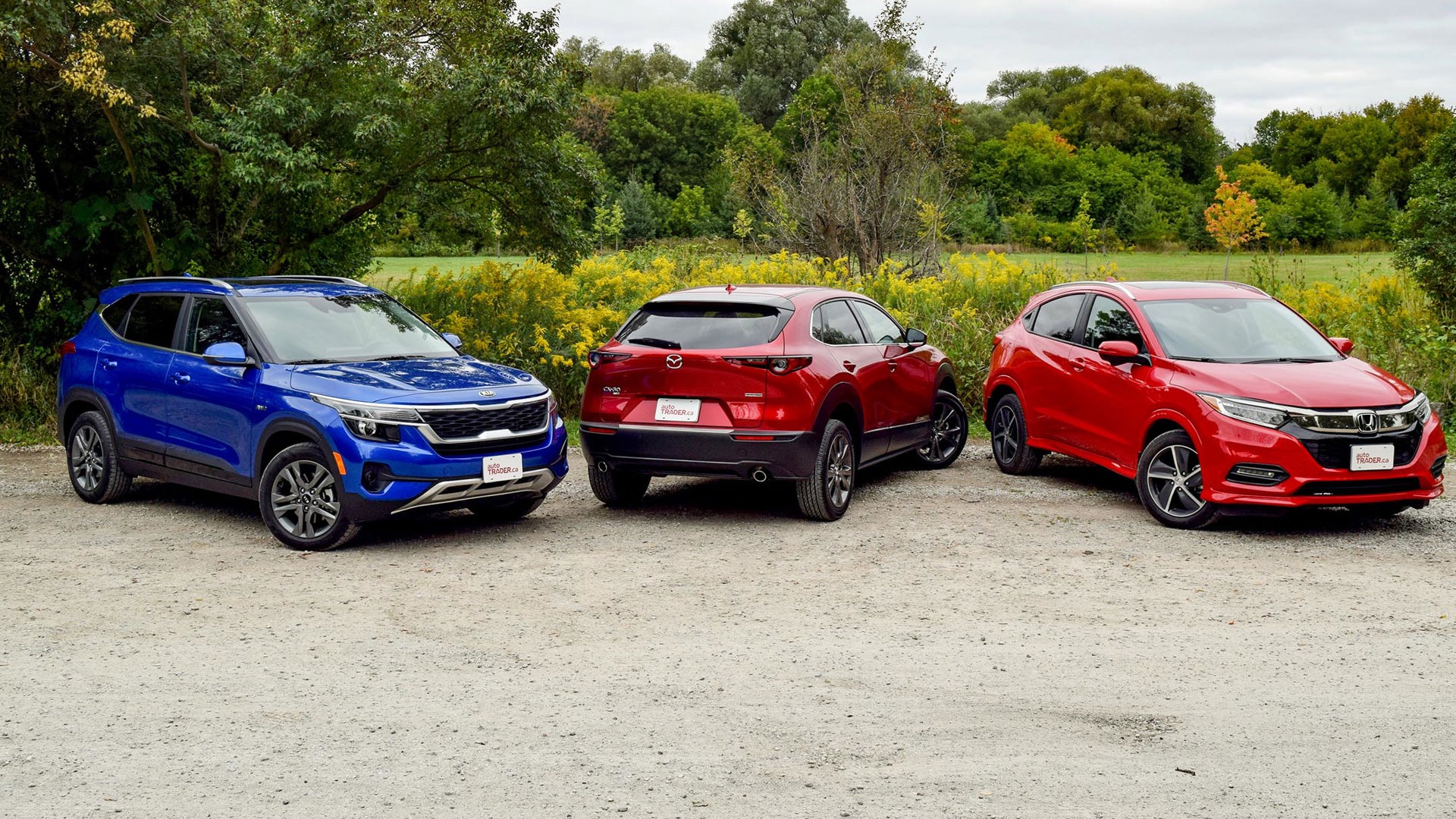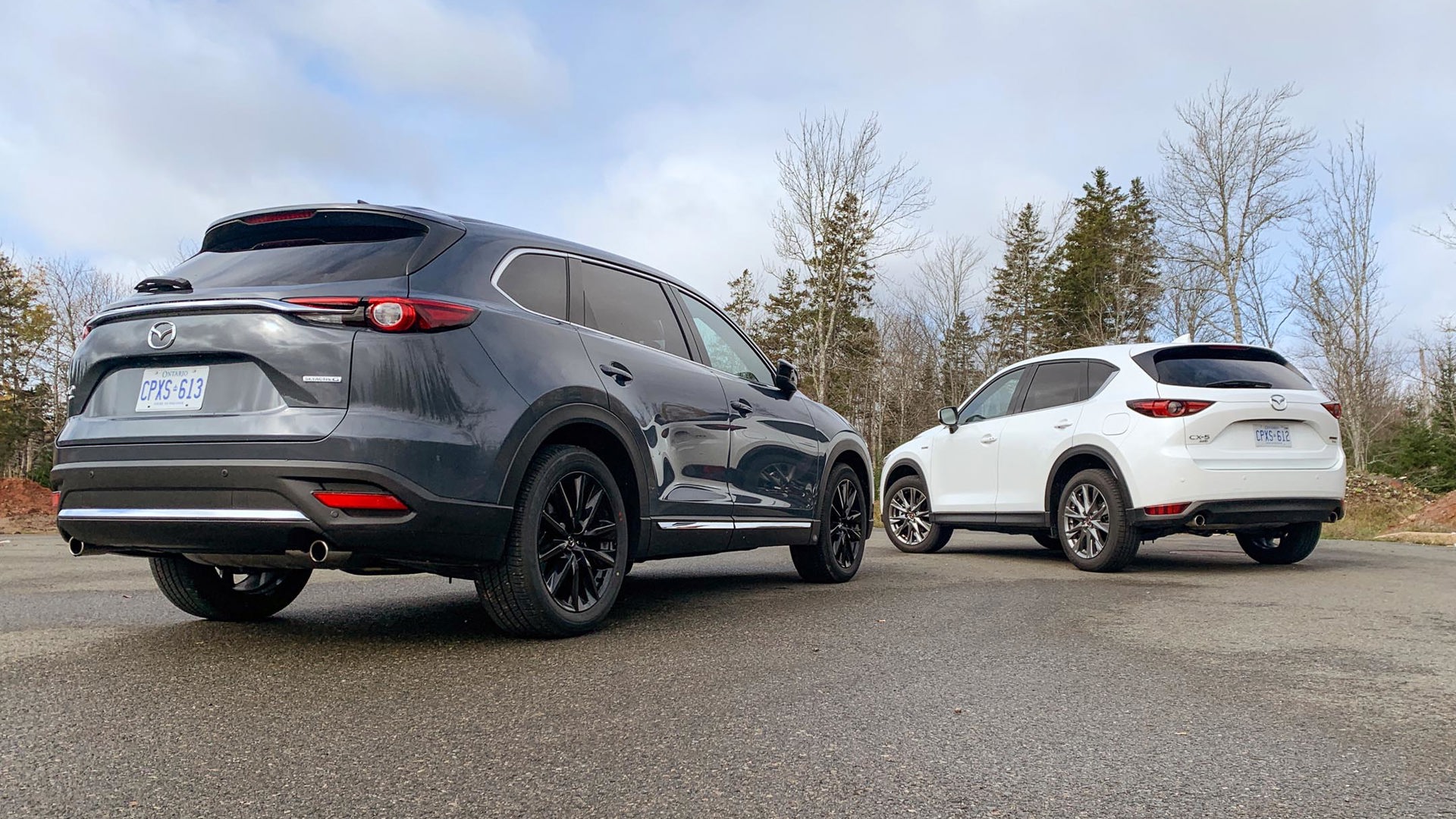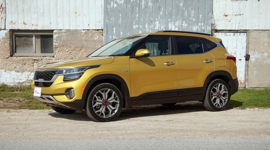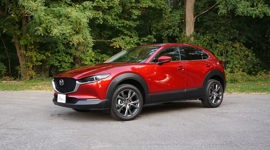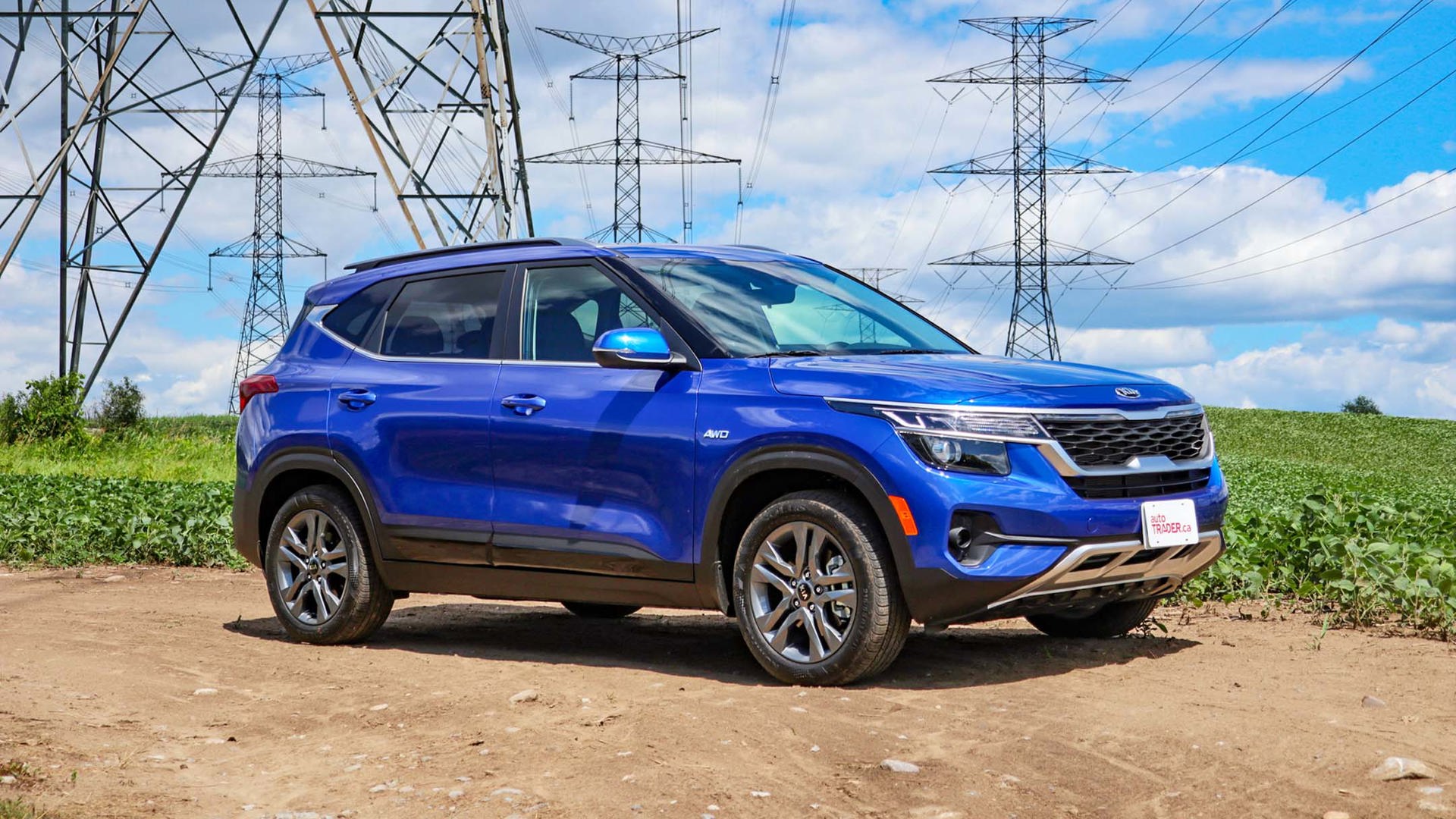Comparison Data
|
2020 Honda HR-V Touring
|
2021 Kia Seltos EX
|
2021 Mazda CX-30 GT
|
|---|---|---|
|
Engine Displacement
1.8L
|
2.0L
|
2.5L
|
|
Engine Cylinders
I4
|
I4
|
I4
|
|
Peak Horsepower
141 hp
|
146 hp
|
186 hp
|
|
Peak Torque
127 lb-ft
|
132 lb-ft
|
186 lb-ft
|
|
Fuel Economy
8.8 / 7.5 / 8.2 L/100 km cty/hwy/cmb
|
8.8 / 7.6 / 8.2 L/100 km cty/hwy/cmb
|
9.9 / 7.7 / 8.9 L/100 km cty/hwy/cmb
|
|
Cargo Space
657 / 1,583 L seats down
|
752 / 1,778 L seats down
|
572 / 1,280 L seats down
|
|
Base Price
$32,900
|
$27,595
|
$33,850
|
|
A/C Tax
$100
|
$100
|
$100
|
|
Destination Fee
$1,840
|
$1,795
|
$1,950
|
|
Price as Tested
$34,840
|
$29,740
|
$36,350
|
|
Optional Equipment
None
|
$250 – Paint, $250
|
$450 – Paint, $450
|
Story and photography by Sami Haj-Assaad. Additional photography by Jodi Lai.
We were stunned by the words spoken by Dustin Woods, Associate Editor here at autoTRADER.ca.
“Hey this isn’t bad,” he said confidently to Editor-in-Chief Jodi Lai and I about the 2020 Honda HR-V. We thought he was joking; after all, this is the man who couldn’t even enjoy his time in a McLaren GT. Yet something about the plucky Honda charmed Dustin, and we were eager to learn more.
Of course, this was his initial impression of the Honda, and his tune changed a bit after some time in the other two crossovers we gathered together for testing. However, his complimentary mood was notable; perhaps someone at Tim Hortons slipped something into his coffee...
Then again, he’s justified in his take on the HR-V. Each of these subcompact crossovers has something worth praising. And each represents a different focus in this segment: the HR-V showcases its endless practicality; the 2020 Mazda CX-30 demonstrates its graceful driving manners; and the 2020 Kia Seltos has the value-packed approach the brand brings with every one of its models. After all our testing, however, only one showcased enough competence to receive our wholehearted recommendation.
Honda HR-V
First debuting in 2015, the Honda HR-V is the oldest vehicle here, originally presented as an all-wheel drive take on the versatile and fun Honda Fit that was named Best Overall Car in the 2020 autoTRADER.ca awards. While the HR-V has plenty of practical touches, the fun-to-drive quotient that helped define the Fit seems lost in translation.
The styling and proportions of the HR-V are honest. It doesn’t look too aggressive or glamorous, and there are no exaggerated details or trendy design cues like the ones found on the other two crossovers in this contest. Best described as conservative or inoffensive – save for the wheel design, yuck! – it has the least visual impact compared to the other two vehicles.
The interior is also a bit on the drab side, though it is uncluttered and somewhat minimalist. The reason for this lack of clutter lies in Honda’s use of touch-sensitive buttons for HVAC and audio, which are difficult to use while driving.
Fortunately, the HR-V is user-friendly in other ways, namely the amount of storage space and storage areas. There are shelves under the gear selector for items like smartphones or loose change, there’s an armrest with storage, and of course, the rear seats fold two ways – seatbacks down flat for maximum cargo space, or seat bottoms upward to help with taller items.
As for numbers, there are 657 L of storage behind the rear seats, and 1,583 L when they're folded. That’s a hefty figure and shows exactly why you’d opt for the HR-V over the other choices here. The rear seats in the HR-V also feel pretty accommodating, and they feature a smidge more legroom than the competition.
Behind the wheel and on the road, the HR-V feels less impressive. Like the Honda Fit before it, the HR-V uses a 1.8L four-cylinder engine that’s good for 141 hp and 127 lb-ft of torque. It uses a continuously-variable transmission (CVT) that does a good job of getting the little crossover up to about 70 km/h or so, but then feels a bit less enthusiastic about higher speeds.
There's an eco button that further dulls the throttle response; using this mode and driving in hurried traffic will almost certainly induce anxiety as other motorists honk or blitz past in the left lane. There’s also a supposed sport mode on the gear selector, suggesting that the vehicle gets more responsive, but instead it just got louder with no noticeable improvement in performance. The motor is buzzy and the lack of sound deadening makes that noise hard to ignore. Like the other vehicles we have here, the HR-V features all-wheel drive, but the base LX model comes in a front-wheel drive format.
While the HR-V isn’t an engaging vehicle to drive it gets the job done and the small wheelbase helps it manage U-turns and squeeze into tight spots. Honda has one of the most enjoyable subcompact hatchbacks in the business with the Fit, but the HR-V sheds that feeling entirely. It’s all business, and that business is practical, efficient transportation. Expect fuel usage to average out to 8.2 L/100 km, which is identical to the 2.0L-powered version of the Kia Seltos.
The Honda HR-V also comes with an excellent list of safety features and driver assistance aids. Items like forward collision warning, lane-departure warning, lane-keep assistance, adaptive cruise control, and automatic high beams are all standard on the HR-V, while Honda's camera-based blind-spot monitoring system is found on the Sport and Touring models. This is an alternative for sensor-based blind-spot monitoring, which we much prefer, though it does help when driving around cyclists in the city. Naturally, the Insurance Institute for Highway Safety (IIHS) has awarded the HR-V with a Top Safety Pick rating – its second-highest award.
Base models start at $24,400 for one with front-wheel drive, while all-wheel traction adds $2,300. The standout features in the LX models include automatic climate control and a touchscreen infotainment with Android Auto and Apple CarPlay compatibility, not to mention all those standard advanced safety features. The Sport model costs $29,700 and gets 17-inch wheels, a black chrome grille, sunroof, fog lights, dual-zone climate control, a slightly more powerful sound system, and a leather-wrapped steering wheel.
The Touring model is $32,900 and gets a few more goodies like leather seating, LED lighting, integrated navigation, and rain-sensing wipers. All these prices exclude the $1,840 freight fee.
The LX AWD seems like it offers the best value, though it feels a bit on the cheap side, while the Touring model is much more expensive without too much extra to show for it.
The HR-V will pair with buyers who want space and safety over anything else. Fortunately for those shoppers, you get all that at the base level. The buyers looking for more will be better served by other choices in this segment.
Pros
Standard safety equipment
Versatile cargo capacity
Decent fuel economy
Cons
Slow
Noisy
Dull to drive
Mazda CX-30
The Mazda CX-30 is a unique option in this segment, with more refinement and an air of sophistication as the Japanese automaker presents its vehicles with styling that could rival luxury brands.
The exterior is very sleek and eye-catching, a result of Mazda’s resistance to body-creasing lines and sharp angles. The trick is in the reflections of the paint job, which look wavy and psychedelic. This pairs best with the extra-cost paint finishes. There’s perhaps a bit too much black body cladding around the wheel wells, and those wheels don’t seem to fill up the space provided for them, leaving us unsatisfied.
Inside, the Mazda CX-30 feels like it’s in another class, with its eye for quality far surpassing the other vehicles here. Buttons and switchgear are tactile rather than vague or mushy. The layout is attractive, too. The only downside to the Mazda interior style is with the infotainment system, which uses a rotary knob to control it, much like an old BMW or Mercedes-Benz – or a current Lexus. Unfortunately, this is paired with a slim screen, limiting the functionality of the system. It caused plenty of frustration during testing.
Adding to that frustration is Mazda’s apparent position on practicality in this class. Namely, it seems like the automaker is betting that buyers of crossovers this size don’t care much about cargo or passenger space. While the front seats are accommodating enough, the CX-30 has much less rear-seat space than the other two vehicles. Furthermore, there are just 572 L of storage behind those seats. The load floor is high, the trunk opening is small, and there are a few awkward humps in the cargo area which further limit its usefulness. Fold those rear seats and you get a total of 1,280 L, which is small compared to the competition.
There’s space under the hood for a 2.5L engine, though, which is among the biggest in this class. It makes 186 hp and 186 lb-ft of torque, which is much more than the HR-V and even the optional 1.6L turbo engine found in the Seltos. For budget-oriented customers, there is a 2.0L engine found in base GX models, which makes 155 hp and 150 lb-ft of torque. However, the 2.5L powering the other two trims feels very confident on the road, working in sync with the six-speed automatic transmission. Fuel economy is the sacrifice, though, as the 2.5L returns 8.9 L/100 km in combined driving conditions, while the 2.0L delivers 8.6 L/100 km.
The CX-30 also offers all-wheel drive, which should be a boost to confidence when inclement weather arrives. Even in normal driving conditions, the powertrain in the CX-30 is excellent. There’s a sport mode that holds gears a bit longer and triggers downshifts sooner. For power-hungry buyers, Mazda will soon offer an even more exciting powertrain in the CX-30: a turbocharged 2.5L engine making 250 hp. This is sure to be a blast to drive.
The way the CX-30 handles is another highlight, with excellent steering and road manners. Mazda’s driving dynamics are second to none in this segment, which is a surprise considering the CX-30 is heavier than the competition here. Thanks to Mazda’s torque vectoring and electronic trickery, the CX-30 delivers a tight connection between the driver’s inputs and the vehicle’s responses. It leads the CX-30 to feel more agile than the other vehicles here, and there’s a distinct sense of sportiness when piloting this small crossover. The relatively heavy steering imbues the ride with a sense of precision. Also, imperfect roads and train tracks don’t seem to jostle the car around, furthering a feeling of a premium vehicle that can handle any road.
The amount of safety equipment in the CX-30 also stands out, with a few important features that are hard to find in other vehicles in this class, including a true head-up display (HUD). The HUD also has little icons that are synced to the vehicle’s blind-spot monitoring, so you have a literal heads up if another motorist is lurking beside you. As expected, the vehicle also offers adaptive cruise control and forward collision warning, as well as a lane-keeping system that operates with a gentler and less panic-inducing approach than that of the Seltos. There's even an attention alert system to keep an eye on drowsy drivers. Like the HR-V, the CX-30 gets a Top Safety Pick rating from the IIHS.
However, all of those positive driving impressions and safety features add up, and the CX-30 can be a very expensive little crossover – a hard pill to swallow in such a small and impractical vehicle. But at least it’s well equipped. A base CX-30 starts at $24,550 for a front-wheel drive model with a 2.0L engine. Adding all-wheel drive bumps the price to $26,050, and these GX models have features like automatic LED headlights, rain-sensing wipers, push-button start, heated front seats, blind-spot monitoring, and an 8.8-inch infotainment system with Android Auto and Apple CarPlay support.
The GS model starts at $27,350 for a front-wheel-drive model – or $28,850 for all-wheel drive – and includes the 2.5L engine. Other features found on GS models include forward collision warning, automatic high beam headlights, and adaptive cruise control, as well as lane-keeping assistance. The GS models also get a leather-wrapped heated steering wheel, dual-zone climate control, and heated side mirrors.
The top trim level, the GT, comes with the 2.5L engine and all-wheel drive and features a price of $33,850. It’s extremely well kitted out with leather seating, a head-up display, power tailgate, parking sensors, integrated navigation system, driver’s seat memory, and a gorgeous brown leather-trimmed interior. These prices don’t include the $1,950 freight fee, and you can also spend extra on the various eye-catching paint finishes that help the CX-30 shine.
If practicality and passenger space are low on your list of priorities, the CX-30 makes a strong case, especially since it’s easy on the eyes and enjoyable to drive. However, the pricing could be a major hurdle to clear.
Pros
Premium looks
Smooth engine
Fun to drive
Cons
Expensive
No cargo or rear passenger space
Cumbersome infotainment
Kia Seltos
The Kia offering in this contest seems a bit more balanced compared to the others. It offers space and practicality like the HR-V, but it also features a responsive driving feel. The Seltos shares quite a lot with the Hyundai Kona, which won the 2020 autoTRADER.ca subcompact crossover of the year award. While those fundamentals mean the Seltos should be a strong contender, the Kona impressed us over a year ago, and we all know that time can change quite a bit, including our impressions of a vehicle in an ever-evolving market.
The design of the Seltos is where you’ll find the most differentiation from its Kona sibling, with Kia offering a more rugged, boxy, and upright design. This contrasts nicely with other crossovers that can just look like subcompact hatchbacks on stilts. However, Kia didn’t really show a lot of restraint in the design cues here, with plenty of chrome bits, and extra angles that may not need to be there. The LED daytime running lights, for example, extend onto the grille, almost making a unibrow for the vehicle, which definitely takes some getting used to. While we can see the simple design of the CX-30 aging well, I’m less confident about the Seltos’ chances of looking stylish in a few years.
The interior is also less fashionable than the CX-30's, but it is much nicer than the HR-V's. There are a few unique details, like the speaker grille design that looks like it could fit on the funky Kia Soul, and little touches like the HVAC recirculate air button featuring a silhouette of a crossover rather than a sedan. The controls do feel a bit cheap, unlike the CX-30. A helpful touch is that the infotainment system in the Seltos is placed high on the dash, making it easy to see and use. The system is also much quicker and easier to use than the ones in the other two vehicles.
The only interior measurement the Seltos loses out on is in rear-seat legroom, where it comes up short by about 30 mm. The trunk space is generous, with 752 L behind the rear seats and 1,778 L with the seats folded. Like the other crossovers here, the seats fold with a 60/40 split but it's noticeable that the Seltos lacks a flat load floor with the seats in the down position.
The Seltos isn’t as boring to drive as the HR-V, yet it isn’t as satisfying as the CX-30. It occupies a happy medium between the two, with just a few noticeable downsides. The steering is a bit light and can feel twitchy at low speeds. While the Kia feels more stable at higher speeds, the lane-keeping system is a bit aggressive, at times pushing you away dramatically from the lane markings. Another odd sensation when driving the Seltos is the touchy feel of the brakes. Again, this is most noticeable at low speeds, and active brakes are hardly a thing to complain about, but it does take some getting used to.
Our Seltos model was equipped with a 2.0L engine that makes 146 hp and 132 lb-ft of torque. It was paired to a CVT which did a good job of keeping engine speed and noise levels at an acceptable level, but once you call for power it spikes the tach and you’ll definitely hear the motor in action. An optional 1.6L turbocharged engine is offered, and it’s paired to a seven-speed dual-clutch automatic transmission. This motor comes just shy of Mazda's 2.5L, with 175 hp and 195 lb-ft of torque, but drivers should appreciate that peak torque comes on as soon as 1,500 rpm, giving a good feeling of thrust from the get-go. Except for the base LX model, which is front-wheel drive, all-wheel drive is found on every Seltos model. The vehicle also has a button to lock the power distribution between the front and rear axles, which will prove to be helpful if you need some help in wintery or slippery conditions.
Kia’s thoughtfulness extends to the pumps, where the Seltos is expected to return combined fuel consumption of 8.2 L/100 km when equipped with the 2.0L engine, or 8.7 L/100 km with the upgraded 1.6L turbocharged engine. The 2.0L engine is more efficient than the HR-V’s 1.8L and the Mazda 2.0L, while the optional engine is more fuel-efficient than the Mazda’s 2.5L.
While the IIHS hasn’t given the Kia Seltos a Top Safety Pick rating, the vehicle does have a solid list of available safety features. Blind-spot monitoring, as well as rear cross-traffic alert, are found as standard equipment, while EX models get lane-keeping assistance, forward collision warning, and an automatic rear cross-traffic avoidance system. EX Premium and SX models get adaptive cruise control, along with a pseudo-HUD with information projected onto a plastic flap.
While the Seltos doesn’t provide its collection of safety features as standard equipment, the pricing is pretty reasonable. Base LX models with front-wheel drive cost $22,995 and have an eight-inch display with Android Auto and Apple CarPlay compatibility, heated front seats, and automatic headlights. Models with all-wheel drive cost an extra $2,000 but the 16-inch steel wheels get upgraded as well to 17-inch alloys. The EX model starts at $27,595 and comes with all-wheel drive as standard, as well as a sunroof, automatic climate control, synthetic leather seats, push-button start, and a heated steering wheel. The $30,595 EX Premium model upgrades the infotainment screen to 10.25 inches, and adds a wireless phone charger, LED headlights and fog lights, heated rear seats, ventilated front seats, and the full collection of safety systems. Finally, the SX Turbo model is $32,595, and that price provides it with the more powerful 1.6L turbocharged engine, a HUD, and an upgraded sound system. Delivery and destination cost $1,795.
Across the lineup, the Seltos is the more affordable vehicle compared to the HR-V and CX-30. It’s also more practical than the other two crossovers, and while it isn’t as engaging to drive as the CX-30, it is a more balanced package.
Pros
Spacious
Less expensive
Fuel-efficient
Cons
Not as much fun to drive
Safety equipment isn’t standard equipment
Less attractive styling
The Verdict
It’s clear that Dustin was impressed by the HR-V’s cargo and safety-focused packaging, but each of these vehicles proudly portrays its strengths. The HR-V may be perfect for those always hauling things around, but its lack of refinement and pokey powertrain leaves us wanting more. The CX-30 swings wildly in the other direction as a fun-to-drive crossover with brilliant styling inside and out. However, its cargo and passenger space is limiting, and Mazda is charging more for this crossover than any other vehicle here. That means if you’re looking for the most crossover for your money the Seltos arrives as the better bargain. It’s spacious, has an impressive list of features, and offers a more powerful engine for those who want it. Best of all, it’s less expensive than the other two vehicles.
If you’re looking for something more specific, like a premium cabin, or standard safety equipment, the other two vehicles here are worth a look, but if your priorities are evenly spread across several criteria it’s easy to recommend the Seltos.

